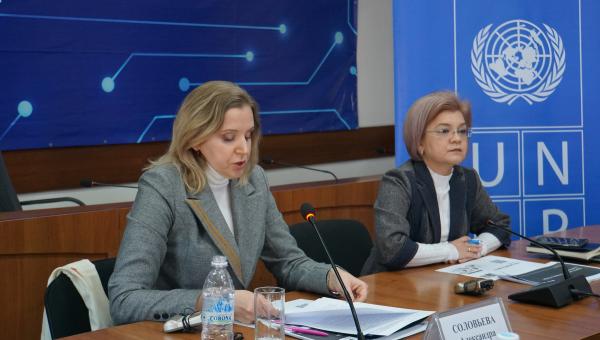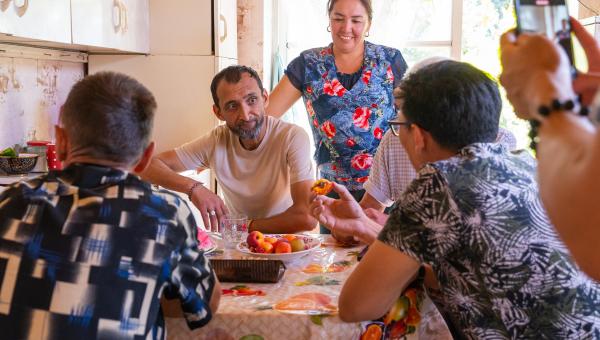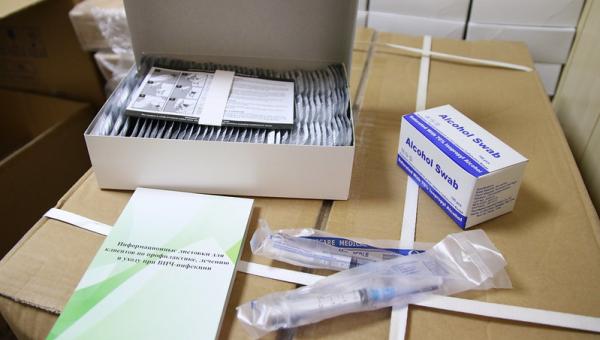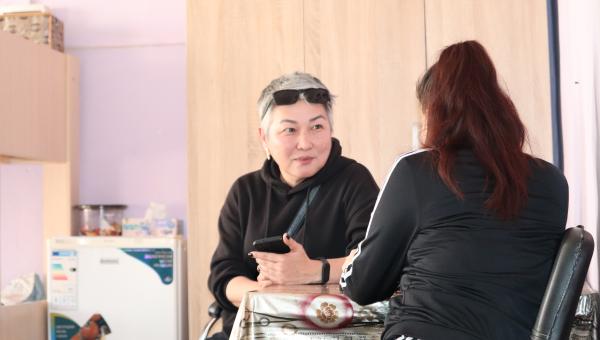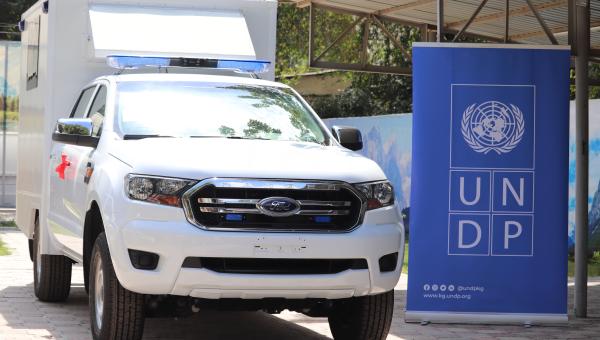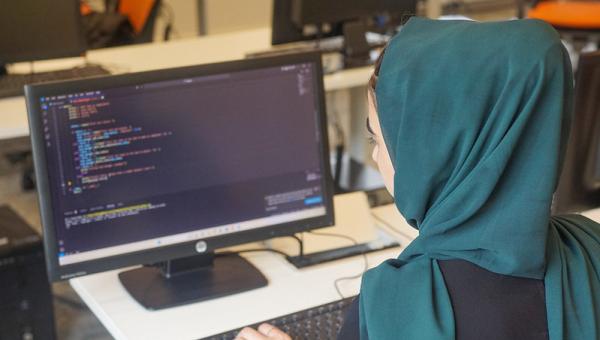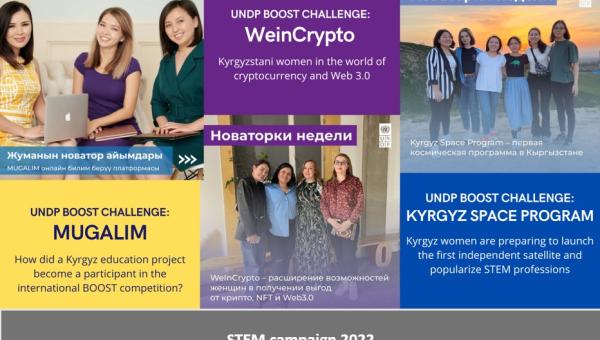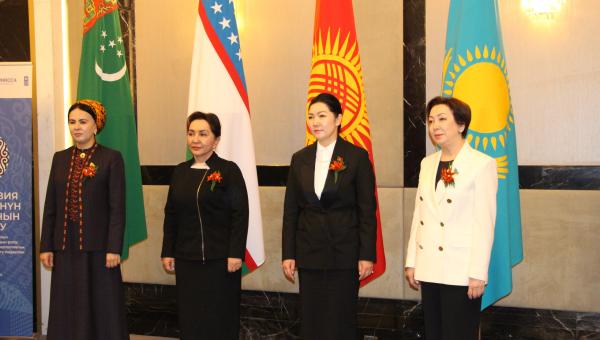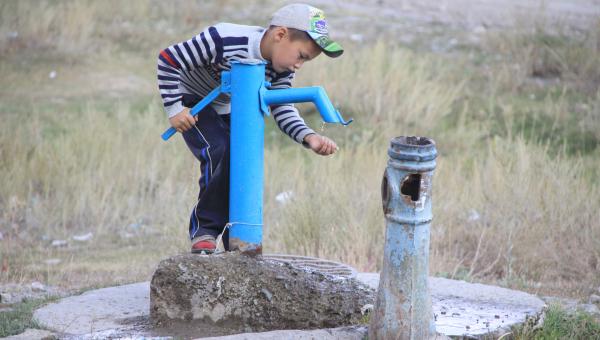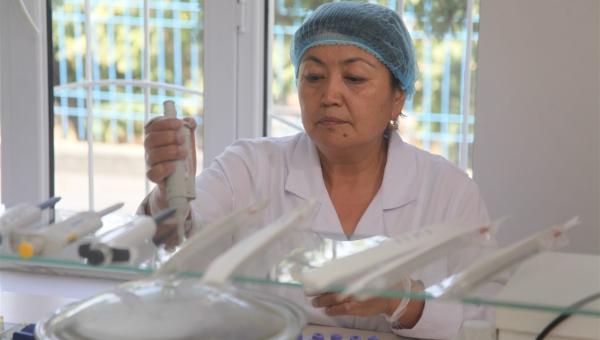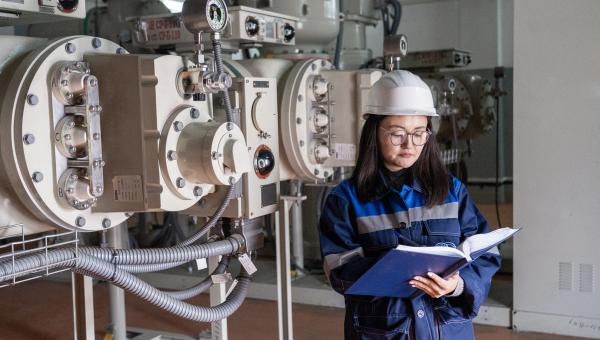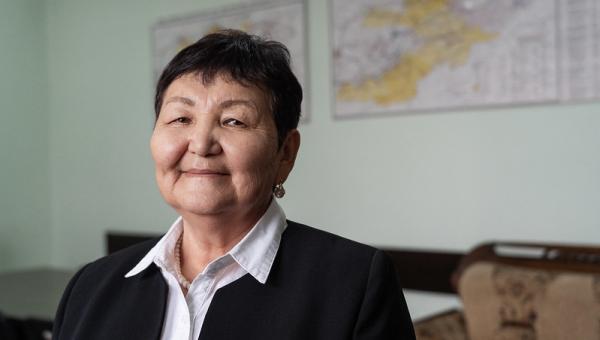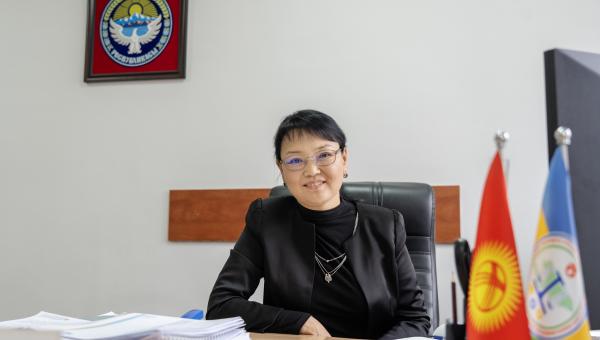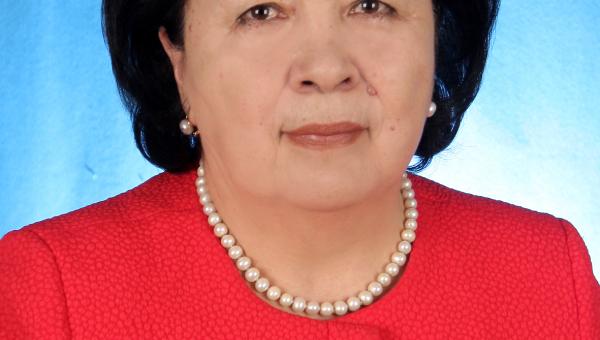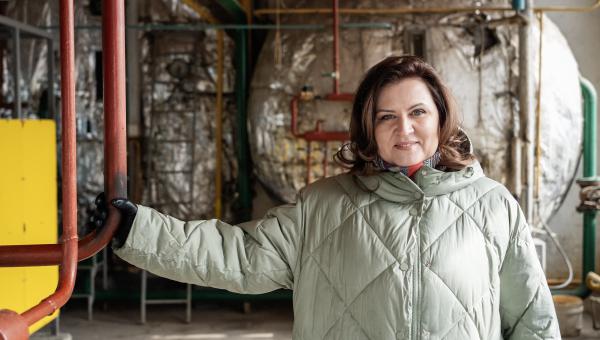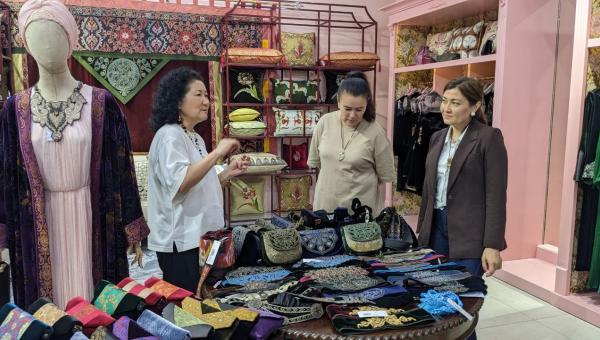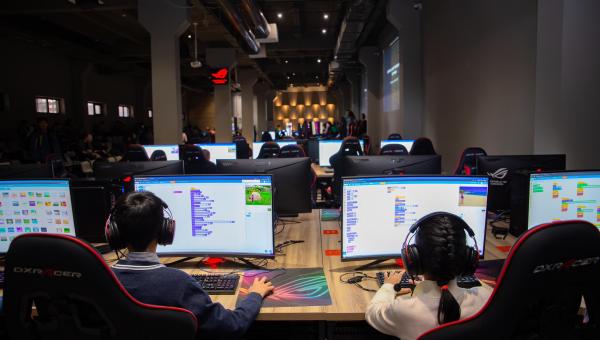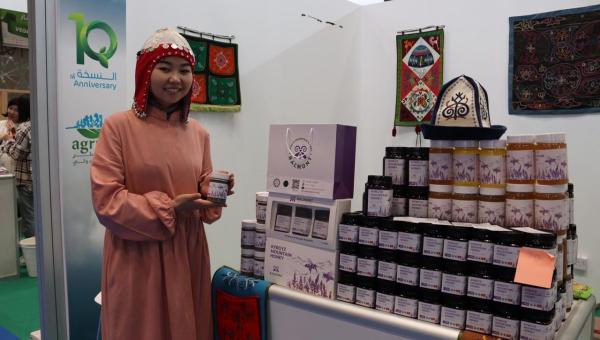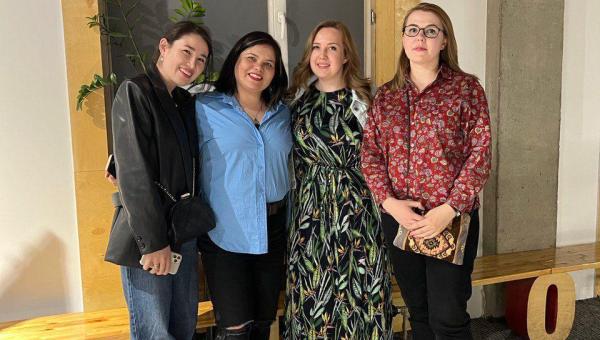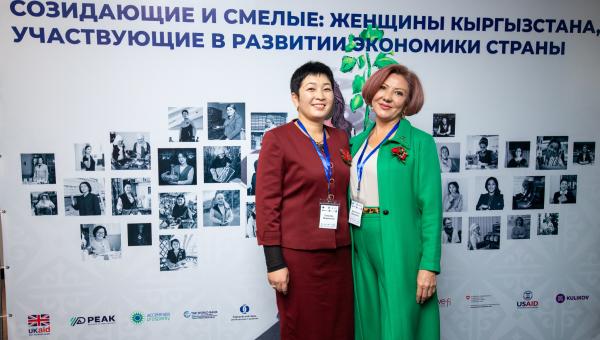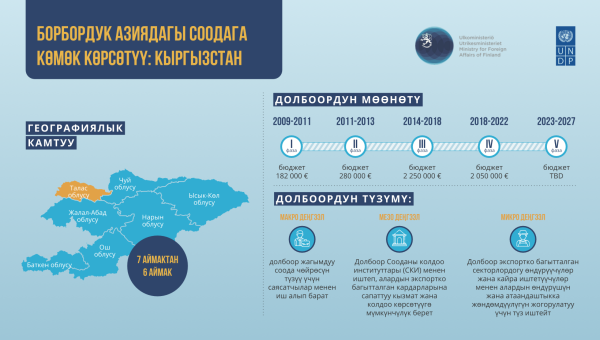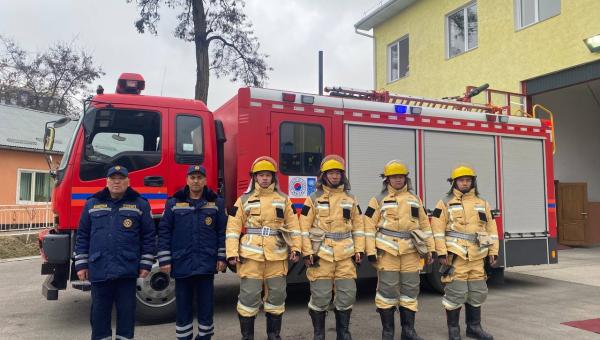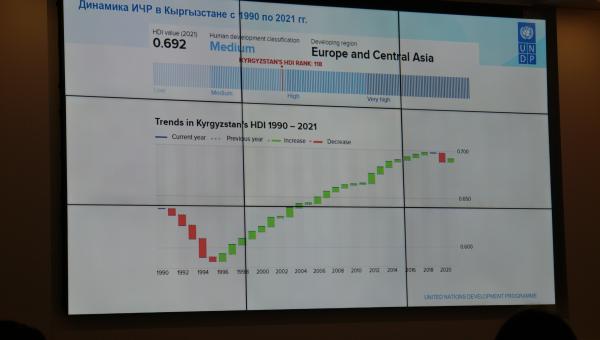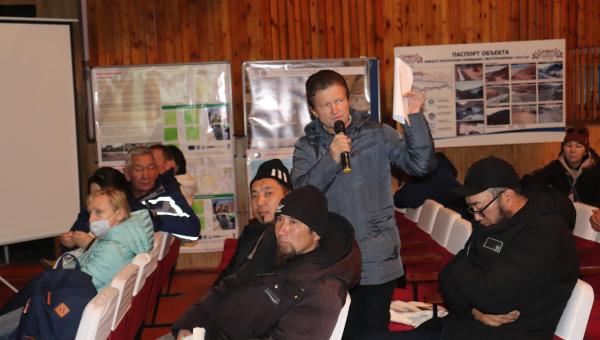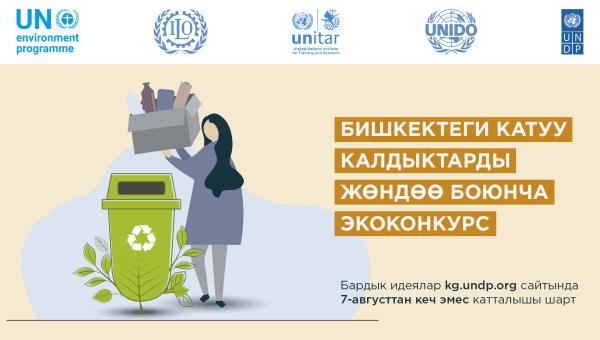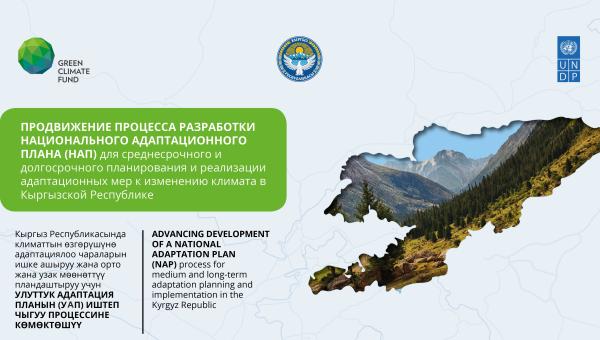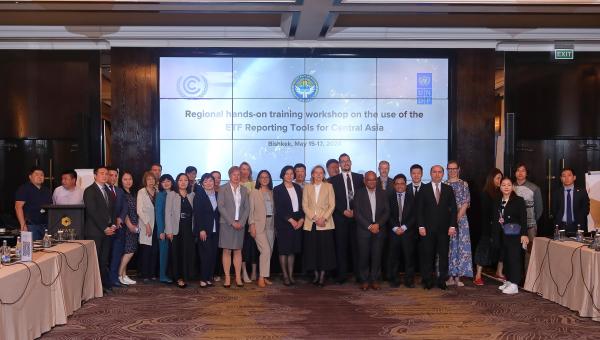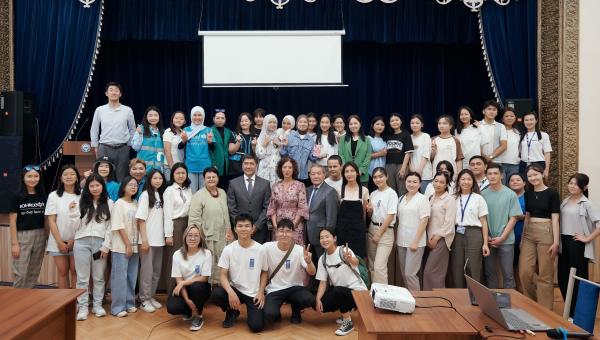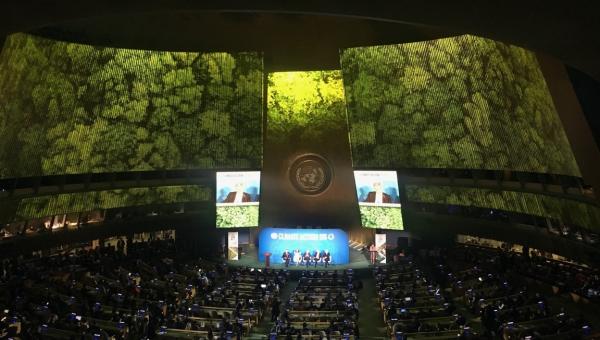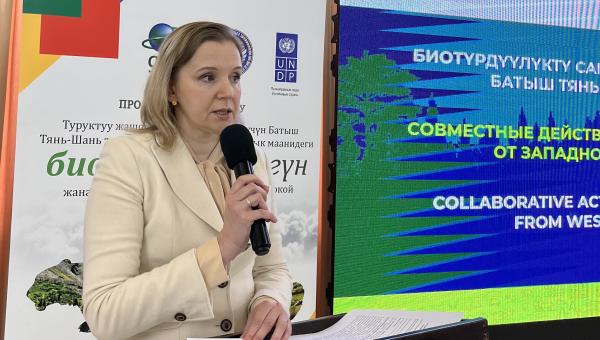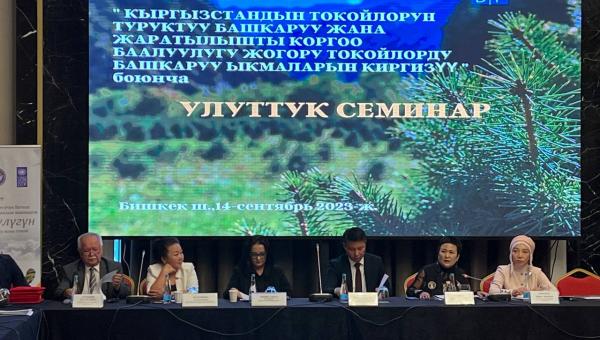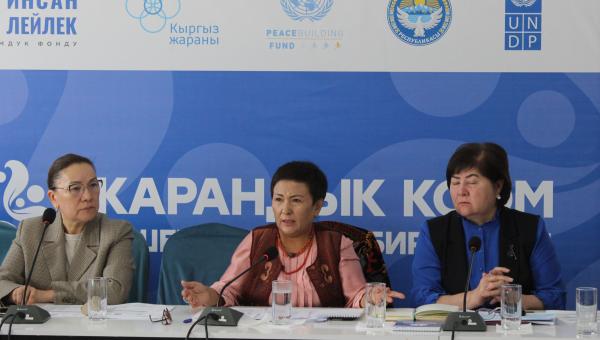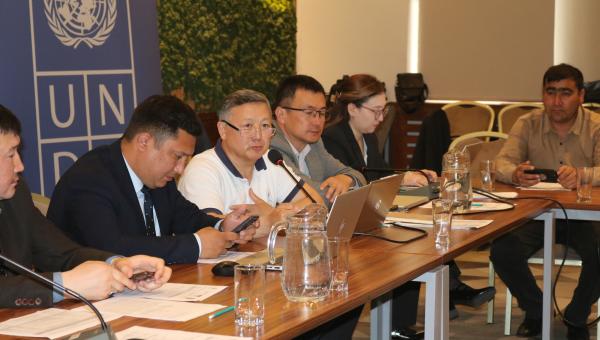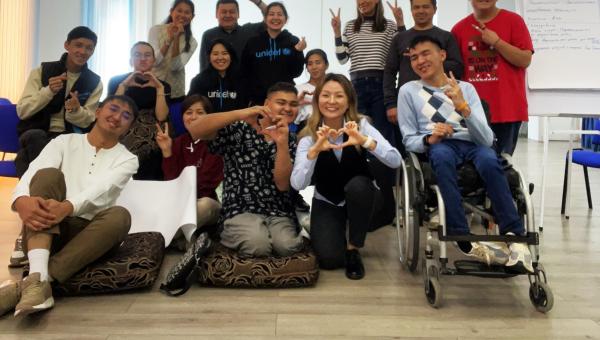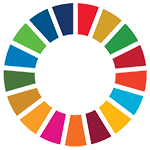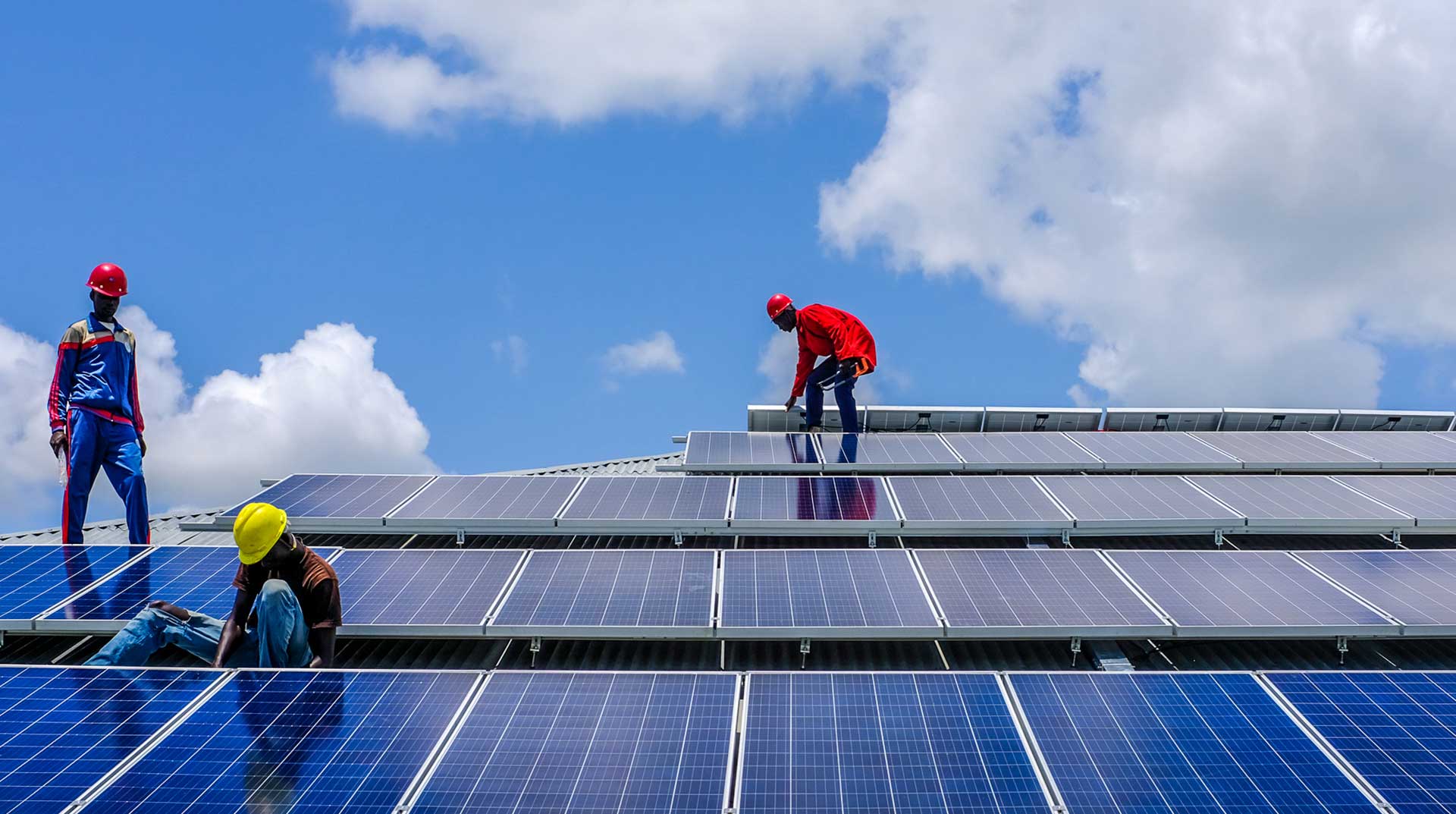
ТӨМ ИШ ЖҮЗҮНДӨ
ТӨМ деген эмне?
Туруктуу өнүгүү максаттары (ТӨМ) же башкача айтканда глобалдык максаттар, 2015-жылы Бириккен Улуттар Уюму тарабынан жакырчылыкты жоюу, планетаны коргоо жана 2030-жылга чейин бардык адамдар тынчтыкта жана өнүгүүдө жашоосун камсыздоо үчүн универсалдуу чакырык катары кабыл алынган.
17 ТӨМ интеграцияланган – алар бир чөйрөдөгү иш-аракеттер башкалардын натыйжаларына таасир этээрин жана өнүгүү социалдык, экономикалык жана экологиялык туруктуулукту тең салмактуулукта кармоого жардам бериши керектигин айгинелешет.
Алдыңкы өлкөлөр эң артта калган башка өлкөлөрдүн прогрессине көбүрөөк көңүл бурууга милдеттенишкен. ТӨМ жакырчылыкты, ачарчылыкты, СПИДди жана аялдар менен кыздарды басмырлоону токтотуу үчүн иштелип чыккан.
Бүткүл коомдогу чыгармачылык, ноу-хау, технология жана каржылык ресурстары кандай гана контекстте болбосун ТӨМгө жетишүү үчүн маанилүү.
1-максат
Жакырчылыкты жоюу
Жакырчылыктын бардык түрлөрүн жоюу адамзаттын алдында турган эң чоң көйгөйлөрдүн бири бойдон калууда. 1990-жылдан 2015-жылга чейин жакырчылыкта жашаган адамдардын санынын жарымы кыскарганына карабастан, көбү дагы эле эң негизги муктаждыктарын канааттандыруу үчүн күрөшүп келишет.
2015-жылга карата, болжол менен 736 миллион адам дагы эле күнүнө 1,90 АКШ долларынан аз акчага жашашат; көбүнө тамак-аш, таза ичүүчү суу жана негизги санитардык-гигиеналык шарттар жетишсиз. Кытай жана Индия сыяктуу өлкөлөрдө тез өсүш миллиондогон адамдарды жакырчылыктан чыгарды, бирок прогресс бардык адамдарга бирдей тараган жок. Аялдар эркектерге караганда көбүрөөк жакырчылыкта жашашат. Анткени алар көбүнчө айлык акысы аз жумуштарда иштешип, билим деңгээли төмөнүрөөк болуп, аялдарга таандык мүлктүн аздыгында.
Өтө жакырчылыкта жашаган адамдардын 80 пайызын түзгөн Түштүк Азия жана Сахаранын түштүгүндөгү Африка сыяктуу башка аймактарда да прогресс толук тараган эмес. Климаттын өзгөрүүсүнөн, чыр-чатактардан, азык-түлүктүн коопсуздугу камсыз кылынбагандыктан келип чыккан жаңы коркунучтар адамдарды жакырчылыктан чыгаруу үчүн көбүрөөк иш талап кылынат дегенди билдирет.
ТӨМ - бул баштаган ишти аягына чыгаруу жана 2030-жылга чейин бардык формадагы жана өлчөмдөгү жакырчылыкты жоюу боюнча чечкиндүү милдеттенме. Бул жоопкерчилик эң аярлуу катмардагы адамдардар менен иштөөнү, маанилүү ресурстарды жана кызматтарды көбөйтүүнү, чыр-чатактардан жана климаттык табигый кырсыктардан жапа чеккен жамааттарды колдоону камтыйт.
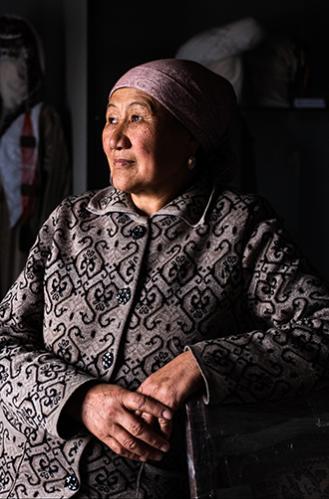
736
миллион
Дүйнө жүзүндө 736 миллион адам дагы эле жакырчылыкта жашайт.
10
пайызы
Дүйнө калкынын 10 пайызы 1990-жылдагы 36 пайызга салыштырмалуу жакырчылыктын эң төмөн деңгээлинде жашайт.
1.3
миллиард
1,3 миллиардга жакын адам көп кырдуу жакырчылыкта жашайт
50
пайыз
Дүйнө жүзү боюнча жакырчылыкта жашагандардын жарымы 18 жашка чейинки адамдар.
10 адамдын
1
Ар бир 10 адамдын бирөөсү жакырчылыкта жашайт
1 - Туруктуу Өнүгүү Максаты
- 2030-жылга чейин улуттук аныктамаларга ылайык, жакырчылыкта жашаган эректердин, аялдардын жана бардык жаштагы балдардын санын жок дегенде жарымына чейин азайтуу
- 2030-жылга чейин бардык эркектер жана аялдар, айрыкча аз камсыз болгондор жана калктын аярлуу катмары экономикалык ресурстарга, ошондой эле базалык кызматтарга, жерге жана жеке менчиктин башка түрлөрүнө, мураска алган мүлккө, табигый ресурстарга, ылайыктуу жаңы технологияларга жана микро каржылоо камтылган финансы кызматтарына ээ болуусун жана башкаруусун камсыз кылуу
- 2030-жылга чейин оор абалда турган жана аз камсыз болгон тараптардын жашоого болгон туруктуулугун жогорулатуу жана климаттын өзгөрүүсүнөн пайда болгон экстремалдык көрүнүштөргө жана башка экономикалык, социалдык жана экологиялык толкундоолорго жана кырсыктарга карата корголуусун жогорулатуу
- Өнүгүп келе жаткан өлкөлөргө, айрыкча азыраак өнүккөн өлкөлөргө бардык түрдөгү жакырчылыкты жоюу боюнча программаларды жана стратегияларды жүзөгө ашыруу үчүн жетиштүү жана алдын ала болжолдонгон каражаттарды берүү үчүн ресурстарды түрдүү булактардан, анын ичинде өнүктүрүү максатында кызматташтыкты активдештирүүнүн негизинде мобилизациялоону камсыз кылуу
- Жакырчылыктын жана гендердик аспекттердин кызыкчылыктарын эске алган улуттук, аймактын жана эл аралык деңгээлдеги ишенимдүү стратегиялык механизмдерди түзүү. Жакырчылыкты жоюу боюнча иш-чараларга инвестицияны тездетүүгө көмөктөшүү
ТӨМ ИШ ЖҮЗҮНДӨ
Максат 2
Ачкачылыкты жоюу
Акыркы жыйырма жылдын ичинде экономиканын тез өсүшүнө жана айыл чарба өндүрүмдүүлүгүнүн жогорулашына байланыштуу толук кандуу тамактанбаган адамдардын саны дээрлик эки эсеге кыскарды. Мурда ачарчылыктан жана начар тамактануудан жапа чеккен көптөгөн өнүгүп келе жаткан өлкөлөр азыр тамак-ашка болгон муктаждыктарын канааттандыра алышат. Борбордук жана Чыгыш Азия, Латын Америкасы жана Кариб деңизиндеги өлкөлөр ачарчылыкты жок кылууда эбегейсиз ийгиликтерге жетишти.
Тилекке каршы, ачарчылык жана начар тамактануу көптөгөн өлкөлөрдө өнүгүүгө чоң тоскоолдук болуп калууда. 2017-жылга карата болжолдуу түрдө 821 миллион адам начар тамактанган, бул көбүнчө айлана-чөйрөнүн бузулушунун, кургакчылыктын жана биологиялык ар түрдүүлүктүн жоголушуна байланыштуу. Беш жашка чейинки 90 миллиондон ашык бала коркунучтуу аз салмакта экени кооптондурат. Африканын жана Түштүк Американын дээрлик бардык аймактарында начар тамактануу жана тамак-аштын катуу тартыштыгы күч алууда.
Туруктуу өнүгүү максаттары 2030-жылга чейин бардык адамдар, өзгөчө балдар, жыл бою жетиштүү тамак-ашка ээ болушун камсыз кылуу аркылуу ачарчылыктын жана жетишсиз тамактануунун бардык түрлөрүн токтотууну көздөйт. Бул - туруктуу айыл чарбасын илгерилетүү, майда фермерлерди колдоо жана айдоо жерлерге, технологияларга жана рынокко бирдей мүмкүнчүлүктү берүүнү камтыйт. Ошондой эле айыл чарба өндүрүмдүүлүгүн жогорулатуу үчүн инфраструктурага жана технологияга инвестиция тартуу үчүн эл аралык кызматташтыкты талап кылат.
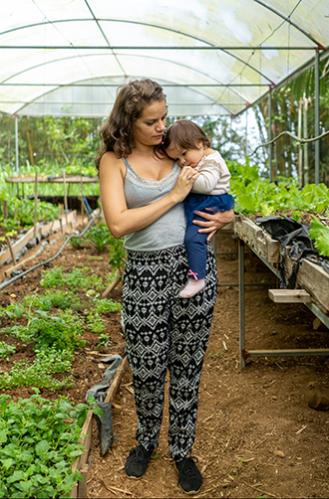
821
миллион
2017-жылы толук кандуу тамактанбаган адамдардын саны 821 миллионго жеткен.
63
пайыз
2017-жылы Азия дүйнөдөгү жетишсиз тамактангандардын дээрлик үчтөн экисин, 63 пайызын түзгөн.
22
пайыз
2017-жылы беш жашка чейинки 22 пайыз, дээрлик 151 миллион баланын бою өсүүсүнөн артта калуу коркучу болгон.
8 ден
1
1/ 8 чоң кишилердин бирөсү ашыкча салмак менен жапа чегет.
3төн
1сү
Репродуктивдүү курактагы ар бир 3 аялдын 1сү аз кандуулук менен жабыркайт.
26
процент
Жумушчулардын 26 проценти айыл чарбасында иштейт.
Максаттар
- 2030-жылга чейин ачарчылыкты жоюу жана баарын, айрыкча аз камсыз болгондорду жана калктын аярлуу катмарын, анын ичинде жаш балдарды жыл боюу коопсуз, пайдалуу жана жетиштүү тамак менен камсыз кылуу
- 2030-жылга чейин ачкачылыктын түрдүү формаларын жоюу, анын ичинде 2025-жылга чейин беш жашка чейинки балдардын өсүшүнүн токтоосуна жана арыктоосуна каршы күрөшүүгө тийиштүү максаттык көрсөткүчтөрдүн макулдашылган эл аралык деңгээлине жетүү жана өспүрүм курактагы кыздардын, кош бойлуулардын, эмизген аялдардын жана улгайган адамдардын тамактанууга болгон талаптарын канааттандыруу.
- 2030-жылга чейин айыл-чарбанын өндүрүмдүүлүгүн жана чакан азык-түлүк өндүрүүчүлөрүнүн, көбүнчө аялдардын, жергиликтүү калктын өкүлдөрүнүн, фермердик үй-бүлө чарбаларынын, малчылардын жана балыкчылардын кирешесин кошулган наркты жана айыл-чарба секторунда жумуш орундарын көбөйтүү үчүн, жерге, башка өндүрүш ресурстарына жана айыл-чарба өндүрүшүнүн факторлоруна, билимге, финансылык кызматтарга, рынокторго жана мүмкүнчүлүктөргө кепилденген жана бирдей деңгээлде жетүүсүн камсыз кылуу аркылуу эки эселентүү.
- 2020-жылга чейин уруктардын жана өрчүтүлгөн өсүмдүктөрдүн, ошондой эле айыл-чарба жана үй-жаныбарларынын жана алардын тийиштүү жапайы түрлөрүнүн генетикалык көп түрдүүлүгүн сактоону камсыз кылуу. Анын ичинде улуттук, аймактык жана эл аралык деңгээлдерде уруктардын жана өсүмдүктөрдүн көп түрдүү банкаларын тийиштүү түрдө кармоо аркылуу сактоо. Генетикалык ресурстарга жана аларга байланышкан салттуу билимдерге жетүүнү кеңейтүүгө жана аларды макулдашылган эл аралык деңгээлдерде колдонуудан келип чыккан пайдаларды адилеттүү жана бирдей негизде, бирдикте колдонууга көмөк көрсөтүү
- 2030-жылга чейин тамак-аш продукттарын өндүрүүнүн туруктуу системаларын түзүү жана айыл-чарбаны жүргүзүүнүн ыкмаларын жүзөгө ашыруу. Бул жашоого болгон туруктуулукту жана өнүмдүүлүктү жогорулатууга, өндүрүштүн көлөмүн жогорулатууга мүмкүнчүлүк берет, экосистеманын сакталышына өбөлгө түзөт. Климаттын өзгөрүүсүнө, аба-ырайынын экcтремалдык көрүнүштөрүнө, кургакчылыкка, суу каптоолорго жана башка кырсыктарга адаптация болуу жөндөмүн чыңдайт жана жердин жана топурактын сапатын акырындан жакшыртат
- Инвестиция кылууну жогорулатуу, анын ичинде айыл-чарба инфраструктурасына, айыл-чарба изилдөөлөрүнө жана агропропагандага эл аралык кызматташтыкты активдештирүү аркылуу жогорулатуу, технологияны өнүктүрүү жана өнүгүп келе жаткан өлкөлөрдүн, айрыкча азыраак өнүккөн өлкөлөрдүн айыл-чарба өндүрүшү тармагында потенциалын чыңдоо максатында өсүмдүктөрдүн жана жаныбарлардын генетикалык банкаларын түзүү
- Өнүктүрүү маселелери боюнча сүйлөшүүлөрдүн Доха раунду мандатына ылайык, айыл-чарба продукциясынын дүйнөлүк рыногунда соода чектөөлөрдүн жана бурмалоолордун пайда болуусун жоюу жана токтотуу. Анын ичинде айыл-чарба продукциясын экспорттоодо субсидиянын бардык формаларын жана ушул сыяктуу окшош кесепеттерге ээ бардык экспорттоо чараларын бирдей жоюу аркылуу токтотуу
- Азык-түлүк товарларынын жана продукциялардын рыногунун тийиштүү түрдө иштөөсүн камсыз кылуу үчүн чараларды кабыл алуу жана азык-түлүккө болгон баанын туруктуулугун камсыздоо максатында рыноктук маалыматтарга, анын ичинде азык-түлүк резервдери тууралуу маалыматтарга өз учурунда жетүүгө көмөк көрсөтүү.
ТӨМ ИШ ЖҮЗҮНДӨ
Максат 3
Жакшы ден соолук жана бакубаттуулук
Биз өлүмдүн жана оорулардын негизги себептери менен күрөшүүдө чоң ийгиликтерге жетиштик. Жашоонун узактыгы кескин өстү; ымыркайлардын жана энелердин өлүмүнүн көрсөткүчтөрү төмөндөдү, биз ВИЧ-инфекциясына каршы кырдаалды өзгөрттүк, безгектен (малярия) каза болгондор эки эсеге кыскарды.
Жакшы ден соолук туруктуу өнүгүү үчүн абдан маанилүү. 2030-жылга чейинки убакыттын күн тартиби бул эки фактордун татаалдыгын жана өз ара байланышын чагылдырат. Ал өсүп жаткан экономикалык жана социалдык теңсиздикти, тез өнүгүп келе жаткан урбанизацияны, климаттык жана экологиялык коркунучтарды, ВИЧтин жана башка жугуштуу оорулардын уланып келе жаткан жүгүн, ошондой эле жугуштуу эмес оорулар сыяктуу көйгөйлөрдү эске алат. Баардык адамдарды саламаттыкты сактоо кызматтары менен толук камтуу ТӨМ-3 кө жетүүнүн, жакырчылыкты токтотуу жана теңсиздикти кыскартуунун ажырагыс бөлүгү болот. ТӨМгө (Туруктуу өнүгүү максаттарына) кирбеген жаңы глобалдык саламаттыкты сактоо максаттары, анын ичинде микробго каршы дарылардын туруктуулукту жараткан абалы аракеттерди талап кылат.
Бирок дүйнө ден-соолукка байланыштуу ТӨМ максаттарына жете албай жатат. Прогресс өлкөлөр ортосунда да, алардын ичинде да бирдей эмес. Эң кыска жана эң узун өмүр сүргөн өлкөлөрдүн ортосунда 31 жылдык ажырым бар. Ал эми кээ бир өлкөлөр таасирдүү жетишкендиктерге жетишкени менен, улуттук орточо көрсөткүчтөр көбү артта калып жатканын жашырат. Теңсиздикти жоюу жана бардыгынын ден соолугун камсыз кылуу үчүн көп секторлуу, укуктарга негизделген жана гендердик мамиле керек.
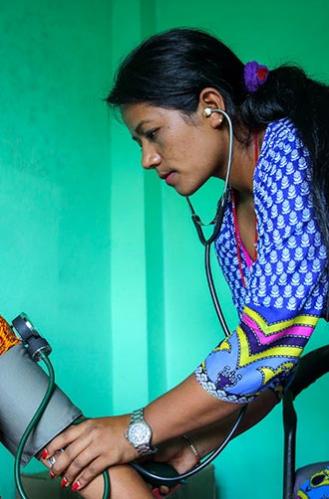
400
млн
Кеминде 400 миллион адам медициналык жардам ала албайт жана элдин 40 пайызы социалдык жактан корголбойт.
1.6
млрд
1.6 миллиарддан ашык адам узакка созулган кризистердин айынан, улуттук саламаттыкты сактоо кызматтарынын алсыздыгынан туруксуз шарттарда жашашат. Бул саламаттыкты сактоонун глобалдык көйгөйү болуп саналат.
15
млн
2017-жылдын аягына карата ВИЧ менен жашаган 21,7 миллион адам антиретровирустук терапиядан өтүшкөн. Бирок, 15 миллиондон ашык адам дагы эле дарыланууну күтүүдө.
2
секунд
Ар бир 2 секунд сайын 30 жаштан 70 жашка чейинки адам жүрөк-кан тамыр оорулары, өнөкөт респиратордук оорулар, диабет же рак сыяктуу жугуштуу эмес оорулардан мезгилсиз дүйнөдөн кайтат.
7
млн
Жыл сайын 7 миллион адам булганган абанын майда бөлүкчөлөрүнүн таасиринен өлөт.
3төн
1
Ар бир үчүнчү аялдын бирден көбү жашоосунун кайсы бир мезгилинде физикалык же сексуалдык зомбулукка кабылган. Бул алардын физикалык, психикалык, сексуалдык жана репродуктивдүү ден соолугуна кыска жана узак мөөнөттүү кесепеттерди алып келет.
Максаттар
- 2030-жылга чейин ымыркайлардын жана 5 жашка чейинки балдар арасында алдын алына турган өлүмдөрдү жокко чыгаруу. Бардык өлкөлөр жаңы төрөлгөн балдардын өлүмүн 1000 төрөлгөндөрдүн арасынан 12ден аштырбаганга жана жана 5 жашка чейинкилер арасында 1000дин ичинен 25тен аштырбаганга аракет кылуусу керек;
- 2030-жылга чейин көңүл бурулбай жаткан СПИД, кургак учук, безгек жана тропикалык оорулардын эпидемиясын токтотуп, гепатит, суу аркылуу жугуучу жана башка жугуштуу оорулар менен күрөшүүнү камсыз кылуу;
- 2030-жылга чейин, психикалык ден-соолукту жана бакубат жашоону бекемдөө, калыбына келтирүү жана сактоо аркылуу жугуштуу эмес оорулардын мезгилсиз өлүмүнүн үчтөн бирин кыскартуу;
- Баңги затка жана алкоголго көз карандылыкты ошону менен бирге, баңги затты жана алкоголдук ичимдиктерди кыянаттык менен пайдаланууну алдын алууну жана дарылоону жакшыртуу;
- 2020-жылга чейин дүйнө жүзү боюнча жол кырсыгынан каза болгондордун жана жаракат алгандардын санын эки эсе кыскартуу;
- 2030-жылга чейин, сексуалдык жана репродуктивдик саламаттыкты сактоо кызматтарына, анын ичинде үй-бүлөнү пландоо, маалымат жана били]м берүү, ошондой эле репродуктивдик ден-соолукту коргоо боюнча маселелерди эске алуу кызматтарын улуттук стратегияга жана программаларга киргизүү;
- Каржылык тобокелдиктен коргоону, бардыгына бирдей болгон сапаттуу медициналык кызматтардын жеткиликтүүлүгүн жана баарына коопсуз, натыйжалуу, сапаттуу жана арзан дары-дармектерди жана вакциналарды камтыган саламаттыкты сактоо кызматтарын камсыз кылуу;
- 2030-жылга чейин, зыяндуу химиялык заттардын таасиринен жана абанын, суунун жана топурактын булгануусунан жана уулануусунан болгон өлүмдөрдүн жана оорулардын санын азайтуу;
- Бүткүл Дүйнөлүк Саламаттыкты Сактоо Уюмунун Тамеки менен күрөшүү боюнча Алкактык конвенциясын бардык өлкөлөрдө жүзөгө ашырууну зарылдыгына жараша күчөтүү;
- Биринчи кезекте өнүгүп келе жаткан өлкөлөргө таасирин тийгизүүчү жугуштуу жана жугуштуу эмес ооруларга каршы вакциналарды жана дары-дармектерди изилдөө жана иштеп чыгууну илгерилетүү, “ТРИПС келишими жана калктын саламаттыгы жөнүндө” Доха декларациясына ылайык, өнүгүп келе жаткан өлкөлөрдүн жеткиликтүү маанилүү дары-дармектердин жана вакциналардын болушун камсыз кылуу укугу бар экендиги тастыкталган, интеллектуалдык менчик укуктарынын соода-сатык аспектилери жөнүндө Макулдашуунун калктын саламаттыгын коргоонун ийкемдүүлүгүнө жана, айрыкча, баарына дары-дармектердин жеткиликтүүлүгүн камсыз кылууга байланыштуу жоболорун толук пайдалануу;
- Өнүгүп келе жаткан өлкөлөрдө, айрыкча өнүкпөгөн өлкөлөрдө жана чакан арал өнүккөн мамлекеттерде саламаттыкты сактоону каржылоону жана медициналык кызматкерлерди жалдоону, жакшыртууну, окутууну жана кармап турууну бир кыйла жогорулатуу;
- Бардык өлкөлөрдүн, айрыкча өнүгүп келе жаткан өлкөлөрдүн, эртелеп эскертүү, тобокелдиктерди азайтуу жана саламаттык сактоонун улуттук жана глобалдык тобокелдиктерин башкаруу мүмкүнчүлүктөрүн өркүндөтүү.
ТӨМ ИШ ЖҮЗҮНДӨ
Максат 4
Сапаттуу билим
2000-жылдан бери бардык балдарга башталгыч билим берүү максатына жетүү боюнча чоң прогресс болду. 2015-жылы өнүгүп келе жаткан аймактарда мектепке баруу 91 пайызга жетти, ал эми дүйнө жүзү боюнча мектепке барбаган балдардын саны дээрлик эки эсеге кыскарды. Ошондой эле сабаттуулуктун деңгээли кескин өстү, буга чейин болуп көрбөгөндөй көп кыздар мектепке бара баштады. Булардын бардыгы албетте, сонун жетишкендиктер.
Кээ бир өнүгүп келе жаткан региондордо жакырчылыктын жогорку деңгээли, куралдуу кагылышуулар жана башка өзгөчө кырдаалдар прогресске жолтоо болууда. Батыш Азияда жана Түндүк Африкада уланып жаткан куралдуу кагылышуулардын натыйжасында мектепке барбаган балдардын саны көбөйдү. Бул тынчсыздандырган тенденция. Сахаранын түштүгүндөгү Африка өлкөлөрү бардык өнүгүп келе жаткан региондорго салыштырмалуу эң көп прогресске жетишсе да (1990-жылдагы 52 пайыздан 2012-жылы 78 пайызга чейин) чоң айырмачылыктар дагы эле сакталып турат. Эң жакыр үй-бүлөлөрдүн балдары эң бай үй-бүлөлөрдүн балдарына караганда төрт эсе көп мектептен калат. Айыл менен шаардын ортосундагы айырмачылыктар дагы эле жогору бойдон калууда.
Баарын инклюзивдик жана сапаттуу билим менен камсыздоо, билим берүү туруктуу өнүгүүнүн эң күчтүү жана далилденген инструменттеринин бири экендигин дагы бир жолу тастыктайт. Бул максат 2030-жылга чейин бардык кыздар жана балдар башталгыч жана орто билимди бекер алышына кепилдик берет. Ал ошондой эле арзан кесиптик билим алууга бирдей мүмкүнчүлүктү камсыз кылууга, гендердик жана мүлктүк теңсиздикти жоюуга жана жалпы калктын сапаттуу жогорку билимге жетишүү максатын көздөйт.

91
пайыз
Өнүгүп келе жаткан өлкөлөрдө башталгыч билим менен камсыз болгон балдардын саны 91 пайызга жетет.
57
млн
Ал эми башталгыч мектеп курагындагы 57 миллион бала мектепке барбайт, алардын жарымынан көбү Сахаранын түштүгүндөгү Африкада өлкөлөрүндө жашашат.
4төн
1
Өнүгүп келе жаткан өлкөлөрдө ар бир төртүнчү кыз мектепке барбайт.
50
пайыз
Мектепке барбаган башталгыч класстардын жарымына жакыны чыр-чатактар болгон аймактарда жашашат.
103
млн
Дүйнөдө 103 миллион жаштардын негизги сабаттуулугу жок, алардын 60 пайыздан ашыгын аялдар түзөт.
10дон
6
10 баланын жана өспүрүмдүн 6сы окуу жана математикалык көндүмдөрдүн минималдуу деңгээлине жетишпейт.
Максаттар
- 2030-жылга чейин, бардык кыздар менен эркек балдардын акысыз, бирдей жана сапаттуу башталгыч жана орто билим алууларын камсыз кылуу, бул окутуунун актуалдуу жана натыйжалуу жыйынтыктарына жетишүү;
- 2030-жылга чейин, бардык кыздар менен эркек балдардын сапатту өнүгүү тутумуна, кенже жаштагы мектепке чейинки балдарга кам көрүүнү жана башталгыч билим алууга даяр экендигин камсыз кылуу;
- 2030-жылга чейин, баардык аялдар менен эркектер үчүн жеткиликтүү жана сапаттуу кесиптик-техникалык жана жогорку билимге, анын ичинде университеттик билимге бирдей мүмкүнчүлүктү камсыз кылуу;
- 2030-жылга чейин талап кылынган көндүмдөргө ээ болгон, ошондой эле кесиптик-техникалык көндүмдөрү менен жумушка орношуу, татыктуу эмгек жана ишкердүүлүк менен алектенүүчү жаштардын жана чоң адамдардын санын жогорулатуу;
- 2030-жылга чейин билим берүүдөгү гендердик теңсиздикти жоюу жана калктын аялуу топторуна, анын ичинде ден-соолугунун мүмкүнчүлүктөрү чектелүү адамдарга, жергиликтүү калкка жана аялуу кырдаалда турган балдарга билим берүүнүн жана кесиптик-техникалык билим берүүнүн бирдей деңгээлин камсыз кылуу;
- 2030-жылга чейин, бардык жаштардын жана калктын улуу катмары болгон эркектердин да, аялдардардын дагы окуй алуусун, жаза алуусун жана санай алуусун камсыздоо;
- 2030-жылга чейин, бардык окуучулардын туруктуу өнүгүүнү илгерилетүү үчүн зарыл болгон билимди жана көндүмдөргө ээ болушун камсыз кылуу, анын ичинде туруктуу өнүгүү жана туруктуу жашоо образын окуу менен, адам укуктары, гендердик теңдик, тынчтык маданиятын жайылтуу жана зордук-зомбулукка жол бербөө, жарандыктын тынчтыгы жана баалуулуктардын маданий ар түрдүүлүгүн аңдап сезүү жана туруктуу өнүгүүгө маданияттын салымы;
- Балдардын кызыкчылыктарын эске алуу менен, майыптарга жана гендердик аспектилерге байланыштуу билим берүү мекемелерин куруу жана өркүндөтүү, баарына коопсуз, эркин, зомбулуксуз, социалдык тоскоолдуктарсыз жана натыйжалуу окуу чөйрөсүн камсыз кылуу;
- 2020-жылга чейин дүйнө жүзү боюнча өнүгүп келе жаткан өлкөлөргө, айрыкча орто өнүккөн өлкөлөргө, кичинекей өнүгүп келе жаткан арал өлкөлөрүнө жана Африка өлкөлөрүнө, өнүккөн өлкөлөр жана башка өнүгүп келе жаткан өлкөлөргө жогорку билим берүү, анын ичинде кесиптик-техникалык билим берүү жана маалыматтык-коммуникациялык технологиялар боюнча маселелер, техникалык, инженердик жана илимий программалар боюнча окутуу үчүн стипендиялардын санын бир кыйла жогорулатуу;
- 2030-жылга чейин, квалификациялуу мугалимдердин санын, анын ичинде өнүгүп келе жаткан өлкөлөрдө, айрыкча орто өнүккөн өлкөлөрдө жана өнүккөн кичинекей арал өлкөлөрдө мугалимдердин билимин жогорулатуу жаатында эл аралык кызматташуу аркылуу көбөйтүү.
ТӨМ ИШ ЖҮЗҮНДӨ
Максат 5
Гендердик теңчилик
Аялдарга жана кыздарга карата бардык басмырлоону токтотуу адамдын негизги укугу гана эмес, ал туруктуу келечек үчүн өтө маанилүү. Аялдардын жана кыздардын мүмкүнчүлүктөрүн кеңейтүү экономикалык өсүшкө жана өнүгүүгө түрткү берээри далилденген.
БУУӨП өз ишинин борборунда гендердик теңчиликти алып, акыркы 20 жылдын ичинде бул багытта олуттуу ийгиликтерге жетиштик. 15 жыл мурункуга караганда азыр мектепте көбүрөөк кыздар окушат жана көпчүлүк аймактарда башталгыч билимде гендердик паритетке жетише алдык.
Бирок эмгек рыногунда аялдардын саны мурдагыдан көп болсо да, кээ бир аймактарда чоң теңсиздик дагы эле сакталып, аялдар эркектер укуктуу болгон жумуштарда иштөө мүмкүнчүлүгүнөн системалуу түрдө ажырап калууда. Сексуалдык зомбулук жана эксплуатация, акы төлөнбөгөн үй жумуштарынын бирдей бөлүштүрүлбөөсү, ошондой эле мамлекеттик кызматта басмырлоо – мунун баары чоң тоскоолдуктар бойдон калууда. Климаттын өзгөрүшү, табигый кырсыктар, чыр-чатактар жана миграция сыяктуу көйгөйлөр аялдар менен балдарга пропорционалдуу эмес таасирин тийгизүүдө.
Аялдарга жер жана менчик, сексуалдык жана репродуктивдүү ден соолук, технология жана интернет боюнча бирдей укуктарды берүү өтө маанилүү. Бүгүнкү күндө мамлекеттик кызматтарда мурдагыдан да көп аялдар бар, бирок лидер аялдардын санын көбөйтүү гендердик теңчиликке жетишүүгө жардам берет.

77
цент
Эркектер бир эле жумуш үчүн алган ар бир доллар үчүн аялдар 77 цент гана алышат.
3төн
1 аял
Аялдардын 35 пайызы физикалык жана/же сексуалдык зомбулукка кабылган.
13
пайыз
Аялдар айыл чарба жерлеринин 13 пайызын гана түзөт.
750
млн
Бүгүнкү күндө дээрлик 750 миллион аял жана кыздар 18 жашка чыкканга чейин турмушка чыгышкан.
3төн
2
Өнүгүп келе жаткан өлкөлөрдүн үчтөн экиси башталгыч билимде гендердик паритетке жетишти.
24
пайыз
2018-жылдын ноябрь айына карата улуттук парламентарийлердин 24 пайызы гана аялдар болгон, бул 1995-жылдагы 11,3 пайыздан бир аз өсүш.
Максаттар
- End all forms of discrimination against all women and girls everywhere Бардык жерде аялдарга жана кыздарга карата басмырлоонун бардык түрлөрүн токтотуу;
- Мамлекеттик жана жеке чөйрөдөгү бардык аялдарга жана кыздарга карата зомбулуктун бардык түрлөрүн, анын ичинде адам сатуу жана сексуалдык эксплуатациянын жана анын башка түрлөрүн жоюу;
- Жаш, эрте жана мажбурлап никеге тургузуу, аялдардын жыныс органдарын кесүү сыяктуу зыяндуу тажрыйбаларды жок кылуу;
- Улуттук шарттарды эске алуу менен, коммуналдык кызматтарды, инфраструктураны жана коопсуздук тармактарын камсыз кылуу, үй чарбасынын жана үй-бүлөнүн жалпы жоопкерчилигин өркүндөтүү аркылуу акысыз тейлөө жумуштарын жана үй жумуштарын таануу жана баалоо;
- Аялдардын толук жана чыныгы катышуусун жана алардын саясий, экономикалык жана коомдук турмуштагы чечимдерди кабыл алуунун бардык деңгээлдеринде жетекчилик кылуусуна бирдей мүмкүнчүлүктөрдү камсыз кылуу;
- Калкты жайгаштыруу жана өнүктүрүү боюнча эл аралык конференциянын иш-аракеттеринин программасына, Пекиндин иш-аракеттеринин платформасына жана кароонун жыйынтыгына ылайык, сексуалдык жана репродуктивдик саламаттыкты сактоо кызматтарына жана репродуктивдик укуктарга жалпы жеткиликтүүлүктү камсыз кылуу;
- Улуттук мыйзамдарга ылайык, аялдарга экономикалык ресурстарга бирдей укуктарды берүү, ошондой эле жерге жана менчиктин башка формаларына, каржылык кызмат көрсөтүүлөргө, мураска жана жаратылыш ресурстарына ээлик кылууга жана контролдоого мүмкүндүк берүүчү реформаларды жүргүзүү;
- Аялдардын мүмкүнчүлүктөрүн жана укуктарын кеңейтүү үчүн жогорку натыйжалуу технологияларды, тактап айтканда маалыматтык-коммуникациялык технологияларды активдүү колдонууну көбөйтүү;
- Гендердик теңчиликти жана бардык деңгээлдеги аялдар менен кыздардын мүмкүнчүлүктөрүн жана укуктарын кеңейтүү үчүн акыйкат саясатты жана милдеттүү мыйзамдарды кабыл алуу жана өркүндөтүү.
ТӨМ ИШ ЖҮЗҮНДӨ
Максат 6
Таза суу жана санитария
Калктын 40%дан ашыгы суунун жетишсиздигинен жапа чегип келет жана бул көңүл чөктүрүүчү көрсөткүч температуранын жогорулашы менен жогорулайт. 1990-жылдан бери санитардык абалы жакшырган адамдардын саны 2,1 миллиардга көбөйгөнүнө карабастан, ичүүчү суунун жетишсиздиги ар бир континентке таасирин тийгизет.
Барган сайын көбүрөөк өлкөлөр суунун тартыштыгын баштан кечирүүдө, ал эми кургакчылыктын жана чөлдүүлүктүн күчөшү бул тенденцияны ого бетер начарлатууда. 2050-жылга чейин кеминде ар бир төртүнчү адамдын бири үзгүлтүксүз суунун жетишсиздигинен жабыркайт деп болжолдонууда.
2030-жылга чейин бардык адамдарды коопсуз жана жеткиликтүү ичүүчү суу менен камсыздоого жетишүү үчүн адекваттуу инфраструктурага инвестициялоо, санитардык жайлар менен камсыз кылуу жана гигиенаны жайылтуу керек. Суу менен байланышкан экосистемаларды коргоо жана калыбына келтирүү абдан маанилүү.
Глобалдык деңгээлде коопсуз жана жеткиликтүү ичүүчү суу менен камсыз кылуу үчүн негизги кызматтардан пайдалана албаган 800 миллиондон ашык адамга жетишүү керек. Ошондой эле, 2 миллиарддан ашык адам үчүн кызмат көрсөтүүлөрдүн жеткиликтүүлүгүн жана коопсуздугун жакшыртуу зарыл.
2015-жылы 4,5 миллиард адам коопсуз санитарияны башкаруу мүмкүнчүлүгүнө ээ болгон эмес (экскрециялар тийиштүү түрдө жок кылынган же тазаланган эмес), ал эми 2,3 миллиард адам эң жөнөкөй санитарияга да ээ болгон эмес.
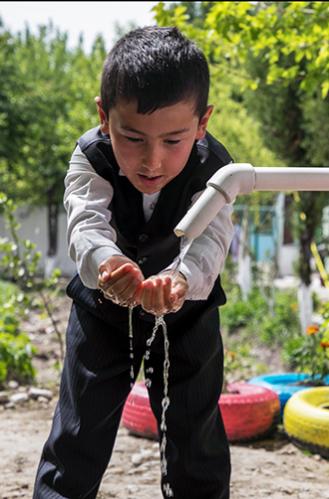
5.2
млрд
2015-жылы дүйнө калкынын 71 пайызы, 5,2 миллиард адам таза ичүүчү сууга ээ болгон, бирок 844 миллион адам дагы деле ичүүчү сууга эң жөнөкөй мүмкүнчүлүктөрү жок.
2.9
млрд
2015-жылы дүйнө калкынын 39 пайызы, 2,9 миллиард адам коопсуз санитарияга ээ болгон, бирок 2,3 миллиард адам дагы эле негизги санитарияга жете алышпайт. 892 миллион адам ачык дефекацияны практикалаган.
80
пайыз
Саркынды суулардын 80 пайызы талаптагыдай тазаланбай суу объекттерин кирдедет.
2
млрд
Суунун жетишсиздигинен 2 миллиарддан ашык адам жабыркайт жана бул сан дагы өсүшү мүмкүн.
80
пайыз
Өлкөлөрдүн 80 пайызы суу ресурстарын комплекстүү башкаруунун пайдубалын түптөгөн.
70
пайыз
Өткөн кылымда дүйнө өзүнүн табигый саздак жерлеринин 70 пайызын жоготкон.
Максаттар
- 2030-жылга чейин, бардыгы үчүн коопсуз жана жеткиликтүү ичүүчү сууга жалпы жана тең укуктуу жеткиликтүүлүккө жетишүү;
- 2030-жылга чейин, жетиштүү санитардык-гигиеналык камсыздоонун жалпы жана бирдей жеткиликтүүлүгүнө жетишип, аялуу кырдаалда турган топтордун, аялдардын жана кыздардын муктаждыктарына өзгөчө көңүл буруп, ачык дефекацияны токтотуу;
- 2030-жылга чейин булганууну азайтуу, таштандыларды жок кылуу жана зыяндуу химикаттарды жана материалдарды чыгарууну минималдаштыруу, тазаланбаган агынды суулардын үлүшүн эки эсе кыскартуу жана агынды сууларды кайра иштетүүнү жана коопсуз пайдаланууну дүйнө жүзү боюнча кыйла жогорулатуу менен суунун сапатын жогорулатуу;
- 2030-жылга чейин суунун жетишсиздигин чечүү жана суунун жетишсиздигинен жапа чеккен адамдардын санын кыскартуу үчүн бардык тармактар боюнча сууну пайдалануунун натыйжалуулугун бир кыйла жогорулатып, таза суунун туруктуу алынышын жана камсыз болушун камсыз кылуу;
- 2030-жылга чейин суу ресурстарын интеграцияланган башкарууну бардык деңгээлдерде, анын ичинде зарыл болгон учурда трансчекаралык кызматташтык аркылуу камсыз кылуу;
- 2020-жылга чейин суу менен байланышкан экосистемаларды, анын ичинде тоолорду, токойлорду, саздак жерлерди, дарыяларды, суу катмарларын жана көлдөрдү коргоо жана калыбына келтирүү;
- 2030-жылга чейин суу менен камсыздоо жана санитария боюнча иш-чараларды жана программаларды, анын ичинде сууну жыйноо, тузсуздандыруу, сууну натыйжалуу пайдалануу, агынды сууларды тазалоо жана кайра иштетүү жана технологияларды кайра иштетүү боюнча өнүгүп келе жаткан өлкөлөрдүн потенциалын бекемдөө үчүн эл аралык кызматташтыкты жана колдоону кеңейтүү;
- Суу чарбасын жана санитарияны башкарууну жакшыртууга жергиликтүү жамааттардын катышуусун колдоо жана бекемдөө.
ТӨМ ИШ ЖҮЗҮНДӨ
Максат 7
Арзан жана таза энергия
2000-2018-жылдар аралыгында электр жарыгы бар адамдардын саны 78 пайыздан 90 пайызга чейин өссө, электр жарыгы жок адамдардын саны 789 миллионго кыскарган.
Бирок, калктын саны өскөн сайын, арзан энергияга болгон суроо-талап күчөйт жана казылып алынган отундун экономикасы климатыбызда кескин өзгөрүүлөрдү жаратууда.
Эгер биз 2030-жылга чейин ТӨМ 7ге жетүүнү кааласак күн, шамал жана жылуулук энергиясына инвестиция кылуу, энергия өндүрүмдүүлүгүн жогорулатуу жана бардык адамдарды энергия менен камсыз кылуу абдан маанилүү.
Бардык өлкөлөрдү таза жана эффективдүү энергия менен камсыз кылуу үчүн инфраструктураны кеңейтүү жана технологияны жаңылоо дүйнөдө өсүштү күчөтүп, айлана-чөйрөгө жардам берет.
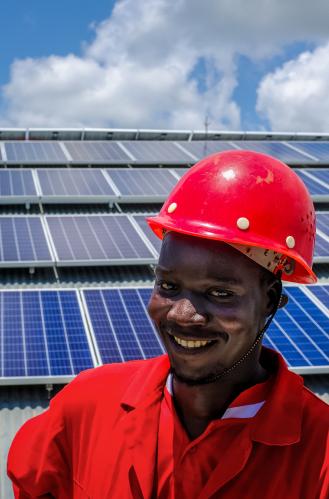
10
пайыз
Ар бир онунчу адамдын дагы эле электр жарыгы жок, алардын көбү өнүгүп келе жаткан өлкөлөрдүн айыл жеринде жашашат. Жарымынан көбү Сахаранын түштүгүндөгү Африка өлкөлөрүндө жашайт.
73
пайыз
Энергетика климаттын өзгөрүшүнүн негизги булагы болуп саналат. Бул адам чыгарган парник газдарынын 73 пайызын түзөт
40
пайыз
Энергоэффективдүүлүктү жогорулатуу негизги фактор болуп саналат; туура энергоэффективдүүлүк саясаты жаңы технологияларды колдонбостон, климаттык максаттарга жетүү үчүн парник газдарынын эмиссиясын талап кылынган кыскартуулардын 40 пайыздан ашыгын камсыздай алат.
2.8
млрд
Дүйнө калкынын дээрлик үчтөн бири - 2,8 миллиарды булгоочу жана зыяндуу тамак бышыруучу отунга көз каранды.
17.5
пайыз
2017-жылы электр энергиясынын 17,5 пайызы кайра жаралуучу булактардан өндүрүлгөн.
18
млн
Кайра жаралуучу энергия тармагында 2019-жылы рекорддук көрсөткүч 11,5 миллион адам иштеген. Париж келишиминин температуранын көтөрүлүшүн 2 градустан төмөн чектөө максаттарына жетишүү үчүн энергия өндүрүүдө жана колдонууда зарыл болгон өзгөртүүлөр 18 миллион жаңы жумуш орундарын түзүшү мүмкүн.
Максаттар
- 2030-жылга чейин арзан, ишенимдүү жана заманбап энергия булактарына жалпы жеткиликтүүлүктү камсыз кылуу;
- 2030-жылга чейин, энергиянын дүйнөлүк энергетикалык баланстын жаңылануучу энергиянын үлүшүн бир кыйла көбөйтүү;
- 2030-жылга чейин, энергетикалык натыйжалуулуктун глобалдык көрсөткүчүн жогорулатуу;
- 2030-жылга чейин эл аралык кызматташтыкты өркүндөтүү, таза энергия жаатындагы изилдөөлөргө жана технологияларга, анын ичинде жаңыланып туруучу энергияга, энергиянын натыйжалуулугуна жана заманбап жана таза казып алынган отун технологияларына, ошондой эле энергетикалык инфраструктурага жана таза энергия технологияларына инвестицияларды тартууга көмөктөшүү;
- 2030-жылга чейин өнүгүп келе жаткан өлкөлөрдө, айрыкча орто өнүккөн өлкөлөрдө, чакан өнүккөн арал өлкөлөрдө жана деңизге чыгууга мүмкүнчүлүгү жок өлкөлөрдө, алардын колдоо программаларына ылайык, заманбап жана туруктуу энергия менен камсыз кылуу үчүн инфраструктураны кеңейтүү жана технологияларды жаңыртуу.
ТӨМ ИШ ЖҮЗҮНДӨ
Максат 8
Татыктуу жумуш жана экономикалык өсүү
Акыркы 25 жылдын ичинде 2008-жылдагы экономикалык кризистин жана дүйнөлүк рецессиянын узакка созулган таасирине карабастан, өтө жакырчылыкта жашаган жумушчулардын саны кыйла кыскарды. Өнүгүп келе жаткан өлкөлөрдө азыр жалпы жумуш менен камсыз болгон орто класстагы адамдар 34 пайызды түзөт, бул 1991-жылдагы деңгээлден үч эсеге көбүрөөк.
Бирок, дүйнөлүк экономика калыбына келген сайын, биз дүйнөдөгү өсүш жайлап, теңсиздик күчөп, саны өсүп жаткан жумушчу күчү үчүн жумуш орундарынын жетишсиздигин көрүп жатабыз. Эл аралык эмгек уюмунун маалыматы боюнча, 2015-жылы жумушсуздардын саны 204 миллиондон ашты.
Туруктуу өнүгүү максаты туруктуу экономикалык өсүштү, өндүрүмдүүлүктү жогорулатууну жана технологиялык прогрессти талап кылат. Ишкердикти стимулдаштыруу, жумуш орундарын түзүү жана мажбурлап иштетүүнү, кулчулукту жана адам сатууну жоюу бул процессте негизги максат болуп саналат. Бул максаттарды эске алуу менен, 2030-жылга чейин бардык аялдар жана эркектерди толук, эффективдүү жана татыктуу жумуш орундары менен камсыздоо чоң максат болуп саналат.
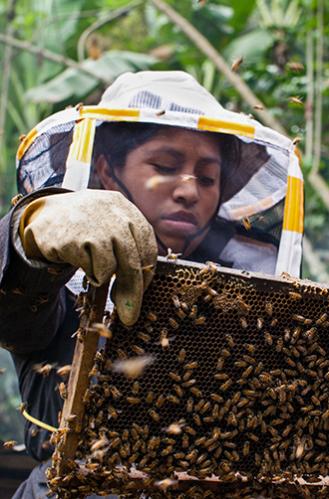
5
пайыз
2018-жылы дүйнө жүзү боюнча болжол менен 172 миллион адам жумушсуз болгон, жумушсуздуктун деңгээли 5 пайызды түзгөн.
1
млн
Жумушчу күчүнүн кеңейүүсүнүн натыйжасында жумушсуздардын саны жыл сайын 1 миллион адамга өсүп, 2020-жылга чейин 174 миллионго жетиши күтүлүүдө.
700
млн
2018-жылы 700 миллионго жакын жумушчу жакырчылыкта жашап, күнүнө 3,20 доллардан азыраак акча короткон.
48
пайыз
Аялдардын эмгекке катышуусу 2018-жылы 48 пайызды түзсө, эркектердики 75 пайызды түздү. Болжол менен 2018-жылы жумушчу күч 5 адам болсо, анын үчөө эркектер болгон.
2
млрд
Жалпысынан 2016-жылы формалдуу эмес экономикада 2 миллиардга жакын жумушчу иштеген, бул дүйнөдөгү жалпы иштеген калктын 61 пайызын түзөт.
85
млн
Эркектерге караганда алда канча көп аялдар жумуш менен аз камсыздалат – 55 миллион аял жумушчуга салыштырмалуу 85 миллион эркек жумушчу бар.
Максаттар
- Улуттук шарттарга ылайык калктын жан башына эсептегенде экономикалык өсүштү камсыз кылуу, атап айтканда, өнүкпөгөн өлкөлөрдө ички дүң продуктунун жылына 7 пайыздан кем эмес өсүшү;
- Диверсификация, техникалык модернизация жана инновация аркылуу экономикада өндүрүмдүүлүктүн өсүшүнө жетишүү, анын ичинде кошумча наркы жогору жана эмгекти көп талап кылган тармактарга басым жасоо;
- Өндүрүмдүү ишмердүүлүктү, иш орундарын түзүүнү, ишкердүүлүктү, чыгармачылыкты жана инновациялык иш-аракеттерди өнүктүрүүгө багытталган саясатты илгерилетүү, ошондой эле микро, чакан жана орто ишканаларды расмий түрдө таанууга жана өнүктүрүүгө түрткү берүү, анын ичинде алардын финансылык кызматтарга жеткиликтүүсүнө таасир берүү;
- 2030-жылдын аягына чейинки мезгилдин ичинде керектөө жана өндүрүш тутумдарында глобалдык ресурстарды натыйжалуу пайдаланууну өркүндөтүп, туруктуу керектөө жана өндүрүш үлгүлөрү боюнча 10 жылдык иш-аракет стратегиясында көрсөтүлгөндөй, экономикалык өсүш айлана-чөйрөнүн деградациясы менен коштолбошу үчүн аракет кылуу жана өнүккөн өлкөлөр биринчилерден болуп алектениши керек;
- 2030-жылга чейин бардык аялдар жана эркектер, анын ичинде жаштар жана ден-соолугунун мүмкүнчүлүктөрү чектелүү адамдар үчүн толук кандуу жана үзүрлүү жумушка орношууга жана бирдей маанидеги эмгек үчүн бирдей эмгек акыга жетишүүнү камсыз кылуу;
- 2020-жылга чейин иштебеген, окубаган жана кесиптик чеберчиликке ээ болбогон жаштардын санын кыйла кыскартуу;
- Мажбурлап иштетүүнү түп-тамыры менен жок кылуу, заманбап кулчулукка жана адам сатууга жол бербөө, ошондой эле балдар эмгегинин эң начар түрлөрүнө тыюу салуу жана жоюу, анын ичинде жашы жете элек балдарды аскерге тартуу жана күчүн пайдалануу, ошондой эле 2025-жылга чейин балдар эмгегин жана анын бардык түрлөрүн токтотуу;
- Эмгек укуктарын коргоо жана бардык жумушчулар, анын ичинде эмгек мигранттары, айрыкча мигрант аялдар жана кооптуу жумушта иштегендер үчүн ишенимдүү жана коопсуз эмгек шарттарын камсыз кылуу;
- 2030-жылга чейин, жумуш орундарын түзүүгө, жергиликтүү маданиятка жана жергиликтүү өндүрүшкө өбөлгө түзгөн туруктуу туризмди өнүктүрүүгө багытталган стратегиялардын иштелип чыгышын камсыз кылуу;
- Бардык адамдар үчүн банктык, камсыздандыруу жана финансылык кызмат көрсөтүүлөргө жетүүнү жеңилдетүү жана кеңейтүү боюнча улуттук каржы мекемелеринин мүмкүнчүлүгүн бекемдетүү;
- Өнүгүп келе жаткан өлкөлөргө, айрыкча орто өнүккөн өлкөлөргө, анын ичинде өнүккөн өлкөлөргө соода-сатыкка байланышкан техникалык жардамдын өркүндөтүлгөн интегралдык алкагы аркылуу ”Соода колдоосун” жогорулатуу;
- 2020-жылга чейин жаштарды жумушка орноштуруунун глобалдык стратегиясын иштеп чыгып, ишке киргизиңиз жана Эл аралык Эмгек Уюмунун Глобалдык Жумушчулар Пактын ишке ашыруу.
ТӨМ ИШ ЖҮЗҮНДӨ
Максат 9
Индустриялаштыруу, инновация жана инфраструктура
Инфраструктурага жана инновацияга инвестициялар экономикалык өсүштүн жана өнүгүүнүн маанилүү кыймылдаткычтары болуп саналат. Учурда дүйнө калкынын жарымынан көбү шаарларда жашап жаткандыктан, массалык транспорт жана кайра жаралуучу энергия, ошондой эле жаңы өнөр жайлардын жана маалыматтык- коммуникациялык технологиялардын өсүшү маанилүү болуп баратат.
Технологиялык прогресс жумуш орундарын түзүү жана энергоэффективдүүлүктү жогорулатуу сыяктуу экономикалык жана экологиялык проблемалардын узак мөөнөттүү чечимдерин табуунун негизги ачкычы болуп саналат. Өнөр жайдын туруктуу тармактарды илгерилетүү жана илимий изилдөөлөргө жана инновацияларга инвестициялоо – бул туруктуу өнүгүүгө көмөктөшүүнүн маанилүү жолдору.
4 миллиарддан ашык адамдын дагы эле интернет колдонууга мүмкүнчүлүгү жок. Алардын 90 пайызы өнүгүп келе жаткан өлкөлөрдөн. Бул санариптик ажырымды жоюу маалыматка жана билимге бирдей жеткиликтүүлүктү камсыз кылуу, инновацияларды жана ишкердүүлүктү өнүктүрүү үчүн абдан маанилүү.

2.3
млрд
Дүйнө жүзү боюнча 2,3 миллиард адам негизги санитардык шарттар менен камсыз болгон эмес.
40
пайыз
Кээ бир аз кирешелүү Африка өлкөлөрүндө инфраструктуралык чектөөлөр ишканалардын өндүрүмдүүлүгүн болжол менен 40 пайызга төмөндөтөт.
2.6
млрд.
Өнүгүп келе жаткан өлкөлөрдө 2,6 миллиард адамдын туруктуу электр энергиясы жок.
90
пайыз
4 миллиарддан ашык адамдын дагы эле интернет колдонууга мүмкүнчүлүгү жок. Алардын 90 пайызы өнүгүп келе жаткан өлкөлөрдөн.
2.3
млн.
Кайра жаралуучу энергия тармактарында учурда 2,3 миллиондон ашык адам иштейт. 2030-жылга чейин алардын саны 20 миллионго жетиши мүмкүн.
30
пайыз
Өнүгүп келе жаткан өлкөлөрдө айыл чарба продукциясынын 30 пайызы гана кайра иштетилет, кирешеси жогору болгон өлкөлөрдө 98 пайыз.
Максаттар
- Бардыгына жеткиликтүү жана бирдей жеткиликтүүлүктү камсыз кылууга басым жасап, экономикалык өнүгүүнү жана адамдардын жыргалчылыгын колдоо үчүн регионалдык жана чек ара инфраструктурасын кошо алганда, сапаттуу, ишенимдүү, туруктуу жана бекем инфраструктураны иштеп чыгуу;
- Кеңири жана туруктуу индустриялаштырууга көмөктөшүү жана 2030-жылга чейин өнөр жай иш менен камсыздоону жана ички дүң өнүмдөгү өнөр жай өндүрүшүнүн үлүшүн улуттук шарттарга ылайык бир кыйла көбөйтүү жана начар өнүккөн өлкөлөрдө эки эсе көбөйтүү;
- Чакан өнөр жай тармагынын жана башка ишканалардын, айрыкча өнүгүп келе жаткан өлкөлөрдүн, жеткиликтүү насыяны кошо алганда, каржылык кызматтарга жеткиликтүүлүгүн кеңейтүү жана алардын өндүрүш-тиричилик чынжырлары менен базарларга интеграцияланышын күчөтүү;
- 2030-жылга чейин инфраструктураны модернизациялоо жана өнөр жай ишканаларын ресурстардын натыйжалуулугун жогорулатуу жана таза жана экологиялык жактан таза технологияларды жана өнөр жай процесстерин кеңейтүү аркылуу туруктуу кылуу үчүн, алардын мүмкүнчүлүктөрүнө жараша бардык өлкөлөрдүн катышуусу менен кайра жабдуу;
- Бардык өлкөлөрдө, айрыкча өнүгүп келе жаткан өлкөлөрдө, изилдөө иштерин күчөтүү, өнөр жай тармактарынын технологиялык потенциалын көтөрүү, анын ичинде инновацияларды стимулдаштыруу менен жана 2030-жылга чейин 1 миллион адамга эсептелген Илимий-изилдөө жана иштеп чыгуу иштериндеги кызматкерлеринин санын көбөйтүү, ошондой эле Илимий-изилдөө жана иштеп чыгуу иштерине мамлекеттик жана жеке чыгымдарды көбөйтүү;
- Африка өлкөлөрүнө, өнүкпөгөн өлкөлөргө, деңизге чыгууга мүмкүнчүлүгү жок өнүгүп келе жаткан өлкөлөргө жана өнүгүп келе жаткан чакан арал мамлекеттерге каржылык, технологиялык жана техникалык колдоону жогорулатуу аркылуу өнүгүп келе жаткан өлкөлөрдө инфраструктуранын бекем жана туруктуу өнүгүүсүнө көмөктөшүү;
- Өнүгүп келе жаткан өлкөлөрдө ата мекендик технологиялардын өнүгүүсүн, изилдөөлөрүн жана инновацияларын, анын ичинде өнөр жай тармагын диверсификациялоого жана баштапкы тармактарда кошумча наркты жогорулатууга ыңгайлуу саясий чөйрөнү түзүү жолу менен колдоо;
- Маалыматтык-коммуникациялык технологияларга жеткиликтүүлүктү бир кыйла кеңейтүү жана 2020-жылга чейин өнүкпөгөн өлкөлөрдө Интернетке жалпы жана жеткиликтүү жетүү үчүн аракет кылуу.
ТӨМ аракетте
Максат 10
Теңсиздикти азайтуу
Кирешелердин теңсиздиги күч алууда,эң бай адамдардын 10%ы дүйнөлүк кирешенин 40%на ээ. Ал эми эң жакыр адамдардын 10%ы дүйнөлүк кирешенин 2-7%ын гана алышат. Эгерде өнүгүп келе жаткан өлкөлөрдүн калкынын өсүшүндөгү теңсиздикти эске алсак, анда теңсиздик 11 пайызга өскөн.
Акыркы он жылдыкта кирешелердин теңсиздиги дээрлик бардык жерде өстү, бирок ар кандай темпте. Европада эң төмөнкү, ал эми жакынкы Чыгышта эң жогорку көрсөткүч.
Бул чоңоюп бара жаткан диспропорциялар кирешеси аз адамдардын мүмкүнчүлүктөрүн кеңейтүү жана жынысына, рассасына, улутуна карабастан бардык адамдардын экономикага интерграциялоо үчүн туура саясатты талап кылат.
Кирешелердин теңсиздиги глобалдык чечимдерди талап кылат. Бул финансылык рынокторду жана институттарды жакшыраак жөнгө салуу жана мониторинг жүргүзүүнү талап кылат. Ошондой эле, муктаж болгон региондорду өнүктүрүүгө жардамдарды жана чет өлкөлүк инвестицияларды колдоо керектигин билдирет. Коопсуз миграцияны жана адамдардын мобилдүүлүгүн илгерилетүү да кедейлер менен байлардын ортосундагы ажырымдын кеңейишин жоюу болуп саналат.

22
пайиз
2016-жылы дүйнөлүк кирешенин 22%ын эң байлардын 1%ы алган болсо, эң жакырлардын 50%ы дүйнөлүк кирешенин 10%на гана ээ болгон.
16
пайыз
1980-жылы эң байлардын 1%ы дүйнөлүк кирешенин 16%на ээ болгон. Кедейлердин 50%ы дүйнөлүк кирешенин 8%на гана ээ болгон.
33
пайыз
Экономикалык теңсиздик көбүнесе адамдардын капиталга башынан теңсиз ээлик кылгандыгынан келип чыгат. 1980-жылдан бери дээрлик бардык өлкөлөрдө мамлекеттик байлыкты жеке байлыкка өткөрүү процесси болду. 2016-жылы дүйнөлүк кирешенин 1%ы эң байлардын 33%ында болгон.
39
пайыз
Адаттагыдай эле бизнестин айтымында, дүйнөдөгү эң байлардын 1%ы 2050-жылга чейин 39 пайызга жетет.
2
x
Аялдар эркектерге караганда төлөнбөгөн үй жумуштарына орто эсеп менен эки эсе көп убакыт коротушат.
60
пайыз
Баалоодон өткөн өлкөлөрдүн 60 пайызында аялдар эркектер менен бирдей финансылык кызматтарга ээ болуп, ал эми 42 пайызында гана аялдар жерге ээлик кылуу мүмкүнчүлүгүнө ээ.
Максаттар
- 2030-жылга чейин, калктын төмөнкү 40 пайызынын кирешесинин өсүшүн мамлекеттик орточо көрсөткүчтөн акырындык менен камсыз кылуу;
- 2030-жылга чейин мыйзамдуу колдоп, адамдардын жашына, жынысына, майыптыгына, расасына, улутуна, тегине, динине жана экономикалык же башка абалына карабастан коомдук, экономикалык жана саясий турмушка жигердүү катышуусуна колдоо көрсөтүү;
- Мүмкүнчүлүктөрдүн теңдигин камсыз кылуу жана жыйынтыктардагы келип чыккан теңсиздикти кыскартуу, анын ичинде басмырлоочу мыйзамдарды, саясатты жана практиканы жок кылуу жана ушул максатка ылайыктуу мыйзамдарды, саясатты жана чараларды жайылтуу;
- Тийиштүү саясатты, айрыкча бюджеттик-салыктык саясаттыжана социалдык коргоо жана эмгек акы маселелери саясатын кабыл алып, жана акырындык менен кеңири теңчиликке жеткиликтүүсүн камсыз кылуу;
- Дүйнөлүк каржы базарларын жана мекемелерин жөнгө салуу жана мониторинг жүргүзүү ыкмаларын өркүндөтүп, ырааттуу колдонуу;
- Дүйнөлүк эл аралык экономикалык жана каржы мекемелериндеги чечимдерди кабыл алуу процессинде өнүгүп келе жаткан өлкөлөрдүн көбүрөөк өкүлчүлүгүн жана добуш берүү үнүн камсыз кылуу, бул институттарды натыйжалуу, ишенимдүү, отчеттуу жана мыйзамдуу болуусун камсыз кылуу;
- Пландаштырылган жана жакшы иштелип чыккан миграция саясатын ишке ашыруу аркылуу тартиптүү, коопсуз, мыйзамдуу жана жоопкерчиликтүү миграцияны жана адамдардын мобилдүүлүгүн илгерилетүүгө таасир берүү;
- Дүйнөлүк Соода Уюмунун келишимдерине ылайык, өнүгүп келе жаткан өлкөлөргө, айрыкча начар өнүккөн өлкөлөргө өзгөчө жана дифференциалдык мамиле принцибин ишке ашыруу;
- Улуттук пландарга жана программаларына ылайык, өзгөчө муктаждыгы начар өлкөлөргө, Африка өлкөлөрүнө, өнүгүп келе жаткан кичинекей арал мамлекеттерге жана деңизге чыгууга мүмкүнчүлүгү жок өнүгүп келе жаткан өлкөлөргө, өнүгүүгө расмий жардам жана каржылык агымдарды, анын ичинде түздөн-түз чет өлкөлүк инвестицияларды тартууга үндөө;
- 2030-жылга чейин мигранттар которгон суммадагы операциялык чыгымдарды которулган сумманын 3 пайызына чейин кыскартуу жана чыгымдар 5 пайыздан ашып кеткен акча которуу каналдарын жок кылуу.
ТӨМ ИШ ЖҮЗҮНДӨ
Максат 11
Туруктуу шаарлар жана калктуу конуштар
Жарымыбыздын көбү шаарларда жашайбыз. 2050-жылы жалпы адамзаттын үчтөн экиси – 6,5 миллиард адам шаарларда жашайт деп болжолдонууда. Туруктуу өнүгүүгө шаардык мейкиндиктерди куруу жана алардын башкаруу ыкмаларына олуттуу өзгөртүүлөрдү киргизүүсүз жетишүү мүмкүн эмес.
Шаарлардын тез өсүшү калктын санынын өсүшүнүн жана миграциянын күчөшүнүн натыйжасы болуп саналат. Бул жагдай айрыкча өнүгүп келе жаткан өлкөлөрдө мегаполистердин өсүшүнө алып келди. Ал эми жакыр райондор, жаңы конуштар шаар турмушунун барган сайын маанилүү өзгөчөлүгүнө айланууда.
Шаарларды туруктуу өнүгүү менен камсыз кылуу карьера жана бизнес мүмкүнчүлүктөрүн түзүү, коопсуз жана жеткиликтүү турак жайларды, туруктуу коомду жана экономиканы курууну билдирет. Бул коомдук транспортко инвестициялоону, жашыл коомдук мейкиндиктерди түзүүнү, шаар курууну пландоону жана биргелешип инклюзивдүү башкаруу системасын түзүү керектигин билдирет.
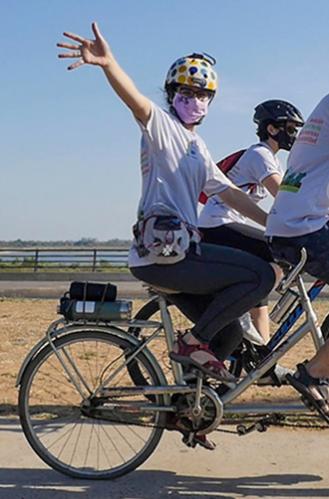
4.2
млрд.
2018-жылы дүйнө калкынын 55 пайызы - 4,2 миллиард адам шаарларда жашашкан. Шаар калкынын саны 2050-жылга чейин 6,5 миллиардга жетет деп күтүлүүдө.
3
пайыз
Шаарлар жердин 3 пайызын гана ээлейт, бирок алар энергияны керектөөнүн 60-80 пайызын жана көмүртектин эмиссиясынын кеминде 70 пайызын түзөт.
828
млн.
Болжол менен 828 миллион адам жакыр райондордо жашайт жана алардын саны күндөн күнгө өсүүдө.
33
шаар
1990-жылы 10 миллион жана андан ашык калкы бар 10 шаар болгон; 2014-жылга карата мегаполистердин саны 28ге чейин өстү, ал эми 2018-жылы алардын саны 33кө жетиши күтүлүүдө. Келечекте 10 мегаполистин 9у өнүгүп келе жаткан өлкөлөрдө болот.
90
пайыз
Жакынкы он жылдыктарда шаарлардын өсүшүнүн 90 пайызы өнүгүп келе жаткан өлкөлөрдө ишке ашат.
80
пайыз
Шаарлардын экономикалык ролу чоң. Алар дүйнөлүк ИДПнын 80 пайызга жакынын өндүрөт.
Максаттар
- 2030-жылга чейин, жетиштүү, коопсуз жана кымбат эмес турак-жайга жана негизги кызматтарга жалпы жеткиликтүүлүктү камсыз кылуу жана начар абалдагы турак-жайларды жаңыртуу;
- 2030-жылга чейин коопсуз, жеткиликтүү, арзан жана экологиялык туруктуу унаалык тутумдар жол коопсуздугун өркүндөтүү менен коомдук унааларды бардыгы пайдалана ала тургандай, айрыкча аялуу кырдаалда турган жактардын, аялдардын, балдардын, майыптардын жана карылар пайдалануусун камсыз кылуу;
- 2030-жылга чейин бардыгы үчүн ачык масштабдагы жана экологиялык туруктуу урбанизацияны жана бардык өлкөлөрдө калктын отурукташуусун бекем жана туруктуу пландаштыруу жана башкаруу мүмкүнчүлүктөрүн кеңейтүү;
- Дүйнөлүк маданий жана жаратылыш мурастарын коргоо жана сактоо боюнча аракеттерди күчөтүү;
- 2030-жылы кырсыктардын кесепетинде ички дүң продукттун жоготуулары түрүндө түз экономикалык зыяндарды азайтып, каза болгондор менен жабырлангандардын санын кескин кыскартуу керек, мында калктын аз камсыз болгон жана талылуу топторуна көңүл буруу керек;
- 2030-жылга чейин калктын санынын эсебинде шаарларга экологиялык терс таасирди азайтуу, анын ичинде абанын сапатына, шаардык жана башка чыгындыларды жоюуга өзгөчө көңүл буруу;
- 2030-жылга чейин баарына, айрыкча аялдарга жана балдарга, улгайган адамдарга жана майыптарга коопсуз, жеткиликтүү жана ачык болгон жашыл аймактарды жана коомдук жайларды ачуу;
- Улуттук жана аймактык өнүктүрүүнү пландоонун сапатын жакшыртуунун негизинде, шаардык, шаар четиндеги жана айылдык райондордун ортосундагы оң маанайдагы экономикалык, социалдык жана экологиялык байланышты колдоо;
- 2020-жылга чейин социалдык тоскоолдуктарды жоюуга, ресурстарды колдонуунун натыйжалуулугун жогорулатууга, климаттын өзгөрүүсүнүн кесепеттерин жумшартууга, анын өзгөрүүсүнө адаптация болууга жана табигый кырсыктарга каршы туруу жөндөмүнө багытталган комплекстүү стратегияларды жана пландарды кабыл алган шаарлардын жана калк жайгашкан пункттардын санын бир кыйла көбөйтүү жана 2015-2030-жж. кырсык болуу тобокелин төмөндөтүү боюнча Сендай рамкалык программасына ылайык, бардык деңгээлде кырсыктарга байланыштуу тобокелдерди комплекстүү башкаруу боюнча чараларды иштеп чыгуу жана жүзөгө ашыруу;
- Азыраак өнүккөн өлкөлөргө көмөк көрсөтүү, анын ичинде жергиликтүү материалдарды колдонуу менен экологиялык туруктуу жана бекем имараттарды курууда финансылык жана техникалык жардам берүү.
ТӨМ ИШ ЖҮЗҮНДӨ
Максат 12
Жоопкерчиликтүү керектөө жана өндүрүш
Экономикалык өсүшкө жана туруктуу өнүгүүгө жетишүү бизден товарларды жана ресурстарды өндүрүү жана керектөө ыкмасын өзгөртүү аркылуу курчап турган чөйрөгө тийгизген таасирин тез арада кыскартууну талап кылат. Айыл чарба дүйнөдөгү суунун эң ири керектөөчүсү болуп саналат жана азыркы учурда сугат адамдар колдонгон таза суунун 70 пайызга жакынын коротот.
Биздин жалпы жаратылыш ресурстарыбызды эффективдүү башкаруу жана уулуу калдыктарды жана булгоочу заттарды утилизациялоо маанилүү көйгөйлөр болуп саналат. Өнөр жайды, ишканаларды жана керектөөчүлөрдүн калдыктарын кайра иштетүүгө жана кыскартууга шыктандыруу өнүгүп келе жаткан өлкөлөрдү 2030-жылга чейин туруктуу керектөө моделине өтүү үчүн колдоо сыяктуу эле маанилүү.
Дүйнө калкынын олуттуу бөлүгү дагы эле эң негизги муктаждыктарын канааттандыруу үчүн өтө аз суу, тамак-аш керектешет. Чекене сатуучулар жана керектөөчүнүн деңгээлинде киши башына дүйнөлүк тамак-аш калдыктарын эки эсеге кыскартуу натыйжалуу өндүрүш жана жеткирүү системасын куруу үчүн маанилүү. Бул азык-түлүк коопсуздугун камсыз кылууга жардам берет жана бизди ресурстарды үнөмдүү колдонуу экономикага жакындатат.
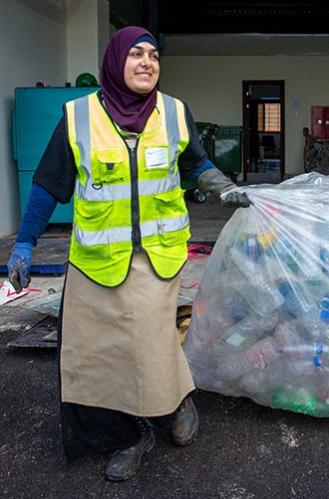
1.3
млрд.
Жыл сайын 1,3 миллиард тонна тамак-аш ысырап болуп, дээрлик 2 миллиард адам ачка калып же начар тамактанат.
22
пайыз
Парник газдарынын эмиссиясынын 22 пайызын тамак-аш сектору түзөт, бу жагдай негизинен токойлорду айыл чарба жерлерине айландыруунун натыйжасында келип чыгат.
2
млрд.
Дүйнө жүзү боюнча 2 миллиард адам ашыкча салмактан же семирүүдөн жабыркайт.
3
пайыз
Дүйнөдөгү суунун 3%ы гана таза (ичүүгө жарамдуу) болуп саналат жана адамдар аны жаратылыш толуктай алгандан да тезирээк түгөтүп жатышат.
120
миллиард АКШ доллар
Эгерде бардык жерде адамдар энергияны үнөмдөөчү лампаларга өтүшсө, дүйнө жылына 120 миллиард доллар үнөмдөмөк.
20
пайыз
2013-жылы дүйнөдөгү энергия керектөөнүн бештен бири кайра жаралуучу булактардан алынган.
Максаттар
- Алгачкылардан болуп өнүккөн өлкөлөрдүн кирүүсү менен, бардык өлкөлөрдүн катышуусу жана өнүккөн өлкөлөрдүн өнүгүүсү жана потенциалы эске алынган, керектөөнүн жана өндүрүүнүн рационалдуу үлгүлөрүн колдонууга өтүү боюнча иш-аракеттердин Он жылдык стратегиясын ишке ашыруу;
- 2030-жылга чейин табигый ресурстардын рационалдуу өздөштүрүлүүсүнө жана натыйжалуу колдонулуусуна жетүү;
- 2030-жылга чейин чекене жана керектөөчү деңгээлдеринде азык-түлүк таштандыларынын жалпы дүйнөлүк санын калктын санынын эсебинде эки эсеге азайтуу жана өндүрүштүк-сатып өткөрүү байланышында, анын ичинде эгин чогултууда азык-түлүктү жоготууну төмөндөтүү;
- 2020-жылга чейин макулдашылган эл аралык принциптерге ылайык, химиялык заттарды жана алардын калдыктарын алардын бүтүндөй жашоо циклинде экологиялык рационалдуу колдонууга жетүү жана алардын адамдардын ден-соолугуна жана курчаган чөйрөгө терс таасирин тийгизүүсүн минимумга түшүрүү үчүн абага, сууга жана топуракка түшүүсүн олуттуу кыскартуу;
- 2030-жылга чейин таштандылардын пайда болуусунун алдын алуу, аларды азайтуу, кайра иштетүү жана кайрадан колдонуу боюнча чараларды кабыл алуу жолу менен алардын көлөмүн олуттуу азайтуу;
- Компанияларга, айрыкча ири жана улуттар аралык компанияларга өндүрүштүн туруктуу ыкмаларын колдонууну жана ресурстарды рационалдуу колдонуу жөнүндө маалыматты отчетторунда чагылдырууну сунуш кылуу;
- Улуттук стратегияларга жана артыкчылыктарга ылайык мамлекеттик сатып алуулардын туруктуу тажрыйбасын камсыз кылууда көмөк көрсөтүү;
- 2030-жылга чейин бүткүл дүйнөдөгү элдер туруктуу өнүгүү жана табият менен таттуу мамиледе жашоо сүрүү жөнүндө тийиштүү маалыматтарга ээ болуусун камсыз кылуу;
- Керектөөнүн жана өндүрүштүн салыштырмалуу рационалдуу үлгүсүнө өтүү үчүн өнүккөн өлкөлөргө алардын илимий-техникалык потенциалын өстүрүүдө жардам көрсөтүү;
- Жумуш орундарын түзүүгө, жергиликтүү маданиятты өнүктүрүүгө жана жергиликтүү продукцияны өндүрүүгө өбөлгө түзө турган, туруктуу өнүгүүгө туруктуу туризмдин тийгизген таасирин мониторинг кылуунун куралдарын иштеп чыгуу жана жүзөгө ашыруу;
- Казып алынган күйүүчү майдын ыксыз сарпталышына алып барган, натыйжасыз субсидиялоо менен айырмаланган колдонууну улуттук шарттарды эске алуу менен рыноктук диспропорцияларды жоюу аркылуу рационалдаштыруу. Анын ичинде салык салууну кайрадан уюштуруу жана алардын экологиялык кесепеттерин каттоо үчүн алар бар болгон жерде зыяндуу субсидиялардан акырындык менен баш тартуу жолу аркылуу рационалдаштыруу. Өнүгүп келе жаткан өлкөлөрдүн өзгөчө керектөөлөрдүн жана шарттарын толук көңүлгө алуу жана муктаж адамдардын жана калктын аярлуу катмарынын кызыкчылыктары корголо тургандай абалда, алардын өнүгүүсү үчүн мүмкүн болгон терс кесепеттерди минимумга түшүрүү.
ТӨМ ИШ ЖҮЗҮНДӨ
Максат 13
Климаттын өзгөрүүсүнө каршы күрөшүү
Климаттын өзгөрүшүнүн кескин кесепеттерин баштан кечирбеген өлкө жок. Парник газдарынын эмиссиясы 1990-жылга салыштырмалуу 50 пайызга көп. Глобалдык ысып кетүү биздин климаттык системабызга узак мөөнөттүү өзгөрүүлөрдү алып келүүдө, эгер биз азыр аракет кылбасак, бул жагдай кайтарылгыс кесепеттерге алып келет.
Климаттын өзгөрүшүнө байланыштуу табигый кырсыктардан орточо жылдык экономикалык жоготуулар жүздөгөн миллиард долларды түзөт. Бул жерде геофизикалык кырсыктардын антропогендик таасирин айтпай эле коёлу, анын 91 пайызы климатка байланыштуу. Бул кырсыктын кесепетинен 1998-2017-жылдар аралыгында 1,3 миллион адам каза болуп, 4,4 миллиард адам жаракат алган. Бул туруктуу өнүгүүнүн максаты - 2020-жылга чейин өнүгүп келе жаткан өлкөлөрдүн климаттын өзгөрүшүнө ыңгайлашуусуна жана аз көмүртек өнүктүрүүгө инвестициялоого болгон муктаждыктарын канааттандыруу үчүн жыл сайын 100 миллиард АКШ долларын мобилизациялоо.
Аярлуу аймактарды колдоо 13-максатты ишке ашырууга гана эмес, башка ТӨМгө да тикелей салым кошот. Бул иш-аракеттер ошондой эле табигый кырсыктардын коркунучун азайтуу, жаратылыш ресурстарын туруктуу башкаруу жана адам коопсуздугунун улуттук өнүгүү стратегияларына киргизүү аракеттери менен бирге жүрүшү керек. Күчтүү саясий эрк, инвестициянын көбөйүшү жана учурдагы технологияларды колдонуу менен дүйнөлүк орточо температуранын өсүшүн өнөр жайга чейинки деңгээлден 2 градус Цельсийге чейин чектөөгө дагы деле мүмкүн, 1,5°Сти көздөп, бирок бул тез жана массалык коомдук аракеттерди талап кылат.
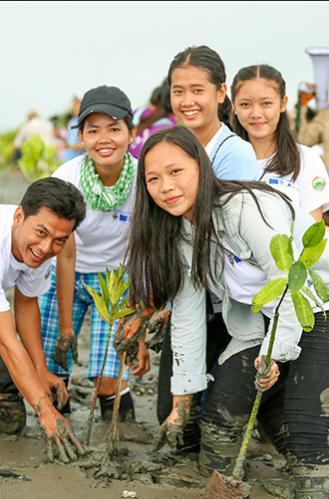
+1°
Цельсий
2017-жылга карата адамдар глобалдык ысып кетүүнү өнөр жайга чейинки деңгээлден 1,0 °C жогорулатты деп болжолдонууда.
+20
см
Деңиз деңгээли 1880-жылдан бери болжол менен 20 см (8 дюйм) көтөрүлдү жана 2100-жылга чейин дагы 30-122 см (1-4 фут) көтөрүлөт деп болжолдонууда.
2050
Ысып кетүүнү 1,5°Сге чейин чектөө үчүн 2010-2030-жылдар аралыгында глобалдык таза CO2 эмиссиясы 45% га төмөндөп, 2050-жылга чейин нөлгө жетиши керек.
1/3
Париж келишиминин алкагындагы климаттык милдеттенмелер дүйнөдөгү температура 2°Cден жогору болуп кетпеши үчүн эмиссияларды кыскартуунун үчтөн бирин гана камтыйт.
26
триллион АКШ доллары
Климаттын өзгөрүшүнө каршы чечкиндүү аракеттер 2030-жылга чейин 26 триллион доллардан кем эмес экономикалык пайда алып келиши мүмкүн.
18
млн.
Энергетика тармагы 2030-жылга чейин болжол менен 18 миллион кошумча жумуш орундарын түзөт, айрыкча туруктуу энергетикада.
Максаттар
- Бардык өлкөлөрдө коркунучтуу климаттык көрүнүштөргө жана табигый кырсыктарга каршылык көргөзүүнү жана адаптация болуу жөндөмүн жогорулатуу;
- Климаттын өзгөрүүсүнө жооп берүү чараларын улуттук деңгээлде саясатка, стратегияларга жана пландоого кошуу;
- Климаттын өзгөрүүсүнүн кесепеттерин жумшартуу жана азайтуу, аларга адаптация болуу жана алдын алуу боюнча маалымат берүүнү жана адамдардын жана ишканалардын мүмкүнчүлүктөрүн жакшыртуу;
- БУУнун климаттын өзгөрүүсү жөнүндө Рамкалык конвенциясынын катышуучулары болуп эсептелген өнүккөн өлкөлөрдүн өздөрүнө алган климаттын өзгөрүүсүнүн кесепеттерин жумшартуу боюнча конструктивдүү чараларды кабыл алуу жана жана аларды жүзөгө ашыруунун ачык болуусун камсыз кылуу чөйрөсүндө өнүккөн өлкөлөрдүн керектөөлөрүн канааттандыруу үчүн бардык булактардан 100 млрд. АКШ долларынын жалпы аракети менен 2020-жылга чейин жыл сайын мобилизациялоо максатына жетүү милдеттерин аткаруусу, ошондой эле Жашыл климаттык фондду мүмкүн болгон кыска убакыт ичинде капитализациялоо жолу менен толук түрдө ишке кирүүсүн камсыз кылуу;
- Азыраак өнүккөн өлкөлөрдө жана чакан аралдардагы өнүгүп жаткан өлкөлөрдө климаттын өзгөрүүсүнө байланышкан, көбүнчө аялдарга, жаштарга, ошондой эле жергиликтүү жана маргиналдык коомдорго өзгөчө көңүл буруу менен пландоо жана башкаруу мүмкүнчүлүктөрүн чыңдоо боюнча механизмдерди түзүүгө көмөк көрсөтүү.
ТӨМ аракетте
Максат 14
Деңиздин экосистемасын сактоо
Дүйнөлүк океандар алардын температурасы, химиялык курамы, агымдары жана жашоосу Жерди адамзат үчүн ылайыктуу кылган глобалдык системаларды башкарат. Биз бул маанилүү ресурсту кантип башкараарыбыз жалпы адамзат үчүн жана климаттын өзгөрүшүнүн таасирин тең салмактоо үчүн абдан маанилүү.
Үч миллиарддан ашык адам жашоосунда деңиздеги жана жээктеги биоартүрдүүлүктөн көз каранды. Бирок бүгүнкү күндө биз дүйнөдөгү балык запастарынын 30 пайызын туруктуу кармап, ашыкча эксплуатациялап жатканыбызды көрүп жатабыз.
Океандар ошондой эле адамдар чыгарган көмүр кычкыл газынын 30 пайызга жакынын сиңирип алат жана биз өнөр жай революциясы башталгандан бери океандын кычкылдануусунун 26 пайызга көбөйгөнүн көрдүк. Деңиздин булганышынын себеби бул жерден чыккан таштандылар. Океандардын чарчы километринде орто эсеп менен 13 000 даана пластик калдыктары бар. Бул сандар коркунучтуу деңгээлге жетип жатат.
ТӨМ туруктуу башкарууга жана деңиз жана жээк экосистемаларын булгануудан коргоого, ошондой эле океандардын кычкылдануусунун кесепеттерин чечүүгө багытталган. Эл аралык укуктар аркылуу океан ресурстарын сактоону жана туруктуу пайдаланууну жакшыртуу да океандардын алдында турган кээ бир кыйынчылыктарды жеңилдетүүгө жардам берет.

75
пайыз
Океан жер бетинин төрттөн үч бөлүгүн ээлейт жана көлөмү боюнча планетадагы жашоо мейкиндигинин 99 пайызын түзөт.
200
миң
Океанда 200 000ге жакын аныкталган жакдыктардын түрү бар, бирок чыныгы саны миллиондогон болушу мүмкүн.
40
пайыз
Океандын 40 пайызга жакыны булгануу, ашыкча балык уулоо, жээктеги жашоо чөйрөлөрүнүн жоголушу жана адамдын башка иш-аракеттеринен улам катуу жабыркады.
30
пайыз
Океан адамдар чыгарган көмүр кычкыл газынын 30 пайызга жакынын өзүнө сиңирип, глобалдык жылуулуктун кесепеттерин азайтат.
3
млрд
3 миллиарддан ашык адам жашоосу үчүн деңиздеги жана жээктеги биоартүрдүүлүктөн көз каранды.
3
триллион АКШ доллары
Деңиз жана жээк ресурстарынын жана өнөр жайларынын рыноктук баасы жылына 3 триллион АКШ долларына бааланат, бул дүйнөлүк ИДПнын болжол менен 5 пайызын түзөт.
Максаттар
- 2025-жылга чейин деңиз чөйрөсүн бардык булгануулардан, анын ичинде кургактагы ишмердиктин жыйынтыгынан, деңиз таштандысы жана азыктануучу заттар менен булгануусунун алдын алуу жана олуттуу кыскартуу;
- 2020-жылга чейин маанилүү терс таасирди азайтуу максатында деңиз жана деңиз жээгинин экосистемасын коргоо жана рационалдуу колдонулуусун камсыз кылуу. Анын ичинде бул экосистемалардын туруктуулугун жогорулатуу жана океандардын жакшы экологиялык абалын жана өндүрүмдүүлүгүн камсыз кылуу үчүн аларды калыбына келтирүү боюнча чараларды кабыл алуу;
- Бардык деңгээлде илимий кызматташтыкты өнүктүрүүнүн натыйжасында океандын кычкылдануу кесепетин төмөндөтүү жана жоюу;
- 2020-жылга чейин балык уулоону натыйжалуу жөнгө салууну камсыз кылуу жана балыктардын баарын кармоого, мыйзамсыз, маалымдалбаган жана жөнгө салынбаган балык уулоого жана өлтүрүүчү балык уулоо тажрыйбасын токтотуу. Ошондой эле мүмкүн болгон кыска мөөнөттө балык запасын калыбына келтирүү үчүн чарба ишмердигинин илимий негизделген планын аткаруу жана аларды жок дегенде бул запастардын биологиялык мүнөздөмөлөрүн эске алуу менен максималдуу экологиялык рационалдуу балык кармоону камсыз кылууга жөндөмдүү деңгээлге жеткирүү;
- 2020-жылга чейин улуттук мыйзамдарга жана эл аралык укуктарга ылайык жана мыкты илимий маалыматтардын негизинде деңиз жээктерин жана деңиз аймактарын табиятты коргоочу чаралар менен жок дегенде 10 пайызын камтуу;
- 2020-жылга чейин ашыкча күчтү жана балыктын баарын кармоону түзүүгө көмөк көрсөткөн балык уулоо үчүн айрым субсидия формаларына тыюу салуу, мыйзамсыз, маалымдалбаган жана жөнгө салынбаган балык уулоого көмөк көрсөткөн субсидияларды жокко чыгаруу жана бул сыяктуу субсидияларды киргизүүнү токтотуу. Өнүгүп жаткан жана азыраак өнүккөн өлкөлөргө карата өзгөчө жана дифференциалдык режимди ылайыктуу жана натыйжалуу түрдө колдонуу, бүткүл дүйнөлүк соода уюмунун алкагында жүргүзүлгөн балык уулоону субсидиялоо жөнүндө маселе боюнча сүйлөшүүлөрдүн ажырагыс бөлүгү болуп саналышы керек;
- 2030-жылга чейин чакан аралдардын өнүгүп жаткан өлкөлөрү жана азыраак өнүккөн өлкөлөр деңиз ресурстарын экологиялык рационалдуу колдонуудан алган, анын ичинде балык чарбасын, аква маданиятын жана туризмди экологиялык рационалдуу уюштуруунун натыйжасында алган экономикалык пайдаларын жогорулатуу;
- Илимий маалыматтардын көлөмүн жогорулатуу, илимий изилдөөлөрдү кеңейтүү жана деңиз технологиялык берүүнү камсыз кылуу. Океан чөйрөсүнүн экологиялык абалын жакшыртуу жана деңиздеги биологиялык көп түрдүүлүктүн өнүгүп жаткан өлкөлөрдүн, айрыкча чакан аралдардын өнүгүп жаткан өлкөлөрү жана азыраак өнүккөн өлкөлөрдүн өнүүгүсүнө кошкон салымын жогорулатуу үчүн Өкмөттөр аралык океанография комиссиясы тарабынан иштелип чыккан деңиз технологияларын берүү боюнча Критерийлерди жана жетекчилик кылган принциптерди эске алуу;
- Кол менен балык уулоо ишмердиги менен алектенген чакан чарбалардын деңиз ресурстарына жана рынокторуна жетүүсүн камсыз кылуу;
БУУнун деңиз укуктары боюнча Конвенциясында бекитилген, “Биз каалаган келечек” документинин 158-пунктунда белгиленгендей, эл аралык укуктардын ченемин сактоо жолу менен океандардын жана анын ресурстарын сактоо жана рационалдуу колдонуу боюнча иштерди жакшыртуу. Бул дүйнөлүк океанды жана анын ресурстарын сактоо жана колдоо үчүн юридикалык базаны түптөйт.
ТӨМ ИШ ЖҮЗҮНДӨ
Максат 15
Жердин экосистемасын сактоо
Адам өмүрү, биздин жашообуз жана тиричилигибиз кургактыктан океан сыяктуу эле көз каранды. Өсүмдүктөр адамдын рационунун 80 пайызын камсыз кылат жана биздин маанилүү экономикалык ресурсубуз айыл чарбасы болуп саналат. Токойлор жер бетинин 30 пайызын ээлейт, миллиондогон жаныбарлардын, өсүмдүктөрдүн ж.б. түрлөрдүн жашоо чөйрөсүн камсыздайт, ошондой эле таза аба менен суунун булагы болуп саналат жана климаттын өзгөрүшүнө каршы күрөшүүдө маанилүү роль ойнойт.
Жыл сайын 13 миллион гектар токой жок болот, ал эми кургак жерлердин тынымсыз начарлашы 3,6 миллиард гектар жерди чөлгө айлантты, жакыр жамааттарга пропорционалдуу эмес түрдө таасирин тийгизүүдө.
Жердин 15 пайызы корголгонуна карабастан, биологиялык ар түрдүүлүк дагы эле коркунучта. Жаныбарлардын жана өсүмдүктөрдүн 7 миңге жакын түрү мыйзамсыз түрдө сатылып кеткен. Жапайы жаныбарларды сатуу биологиялык ар түрдүүлүктү жок кылуу менен гана чектелбестен, коопсуздукка коркунуч келтирет, чыр-чатакты жана коррупцияны күчөтөт.
Биздин жалпы мурастарыбыздын бир бөлүгү болгон жаратылыш чөйрөлөрүнүн жана биологиялык ар түрдүүлүктүн жоголушун азайтуу, глобалдык азык-түлүк жана суу коопсуздугун, климаттын өзгөрүүсүн жумшартуу жана адаптациялоо, тынчтык менен коопсуздукту колдоо үчүн шашылыш чара көрүү зарыл.

1.6
млрд
1,6 миллиардга жакын адам токойлордон көз каранды.
80
пайыз
Жер бетиндеги жаныбарлардын, өсүмдүктөрдүн жана курт-кумурскалардын түрлөрүнүн 80 пайыздан ашыгы токойлордо жашайт.
2.6
млрд.
2,6 миллиард адам айыл чарбасынан түздөн-түз көз каранды.
33
пайыз
2030-жылга чейин жаратылышка негизделген климаттык чечимдер CO2 эмиссиясынын үчтөн бир бөлүгүн азайтышы мүмкүн.
US$125
триллион
Экосистеманын адамдын жашоосу жана жыргалчылыгы үчүн баасы жылына 125 триллион долларды түзөт.
60-80
пайыз
Тоолуу аймактар жер жүзүндөгү таза суунун 60-80 пайызын камсыздайт.
Максаттар
- 2020-жылга чейин жердеги жана ички тузсуз суулардын экосистемасын жана алардын кызматтарын, анын ичинде токойлорду, суулуу-саздуу жерлерди, тоолорду жана кургак жерлерди сактоону, калыбына келтирүүнү жана рационалдуу колдонууну эл аралык макулдашуулардагы милдеттерге ылайык камсыз кылуу;
- 2020-жылга чейин бардык түрдөгү токойлордун рационалдуу колдонуу ыкмасын жүзөгө ашырууга көмөк көрсөтүү, токойлорду кыюуну токтотуу, жок болуп бара жаткан токойлорду калыбына келтирүү жана дүйнө жүзү боюнча дарак олтургузуу жана токойлорду калыбына келтирүү масштабын олуттуу кеңейтүү;
- 2030-жылга чейин чөлгө айланууга каршы күрөш жүргүзүү, жок болуп бара жаткан жерлерди жана топурактарды, анын ичинде чөлгө айланган, кургаган жана суу каптаган жерлерди калыбына келтирүү жана дүйнө жүзү боюнча жерлердин абалынын начарлап кетпөөсүнө аракет кылуу;
- 2030-жылга чейин туруктуу өнүгүү үчүн зарыл болгон пайданы берүү жөндөмүн көтөрүү үчүн тоо экосистемасынын, анын ичинде алардын биологиялык көп түрдүүлүгүн сактоону камсыз кылуу;
- Табигый жашоо чөйрөсүнүн жок болуп кетүүсүн токтотуу боюнча олуттуу чараларды тез арада кабыл алуу, биологиялык көп түрдүүлүктү жоготууну токтотуу жана 2020-жылга чейин жок болуу коркунучунда турган түрлөрдү сактоону жана жоголуусунун алдын алууну камсыз кылуу;
- Генетикалык ресурстарды колдонуудан алган убайды адилеттүү бөлүүгө көмөк көрсөтүү жана макулдашылган эл аралык деңгээлдеги шарттарда мындай ресурстарга тийиштүү түрдө жетүүнү камсыз кылууга өбөлгө түзүү;
- Флора жана фаунанын корголгон түрлөрүнө браконьердик кылууну жана контрабандалык сатууну токтотуу үчүн тез арада чара көрүү жана жандуу жаратылыштын мыйзамсыз продукттарына болгон суроо-талаптарына жана ошондой эле алардын сунуштарына тиешелүү көйгөйлөрдү чечүү;
- 2020-жылга чейин инвазивдик бөтөн түрлөрдүн кирүүсүнүн алдын алуу боюнча жана алардын жердеги жана суудагы экосистемага тийгизген таасирин олуттуу төмөндөтүү боюнча чараларды кабыл алуу, ошондой эле артыкчылыктуу түрлөрдүн санын чектөө же жок кылуунун алдын алуу боюнча чараларды кабыл алуу;
- 2020-жылга чейин жалпы улуттук жана жергиликтүү пландоодо жана өнүктүрүү процесстеринде, ошондой эле жакырчылыктын көлөмүн кыскартуунун стратегияларын жана пландарын иштеп чыгуу учурунда экосистеманын жана биологиялык көп түрдүүлүктүн баалуулугун эске алууну камсыз кылуу;
- Биологиялык көп түрдүүлүктү жана экосистеманы сактоо жана рационалдуу колдонуу максатында бардык булактардан финансылык ресурстарды мобилизациялоо жана олуттуу көбөйтүү;
- Токойду рационалдуу колдонууну каржылоо үчүн бардык булактардан жана бардык деңгээлде олуттуу ресурстарды мобилизациялоо жана өнүгүп жаткан өлкөлөргө башкаруунун мындай ыкмаларын колдонуу үчүн, анын ичинде токойлорду сактоо жана калыбына келтирүү максатында шайкеш стимулдарды берүү;
- Браконьердикке жана корголгон түрлөрдү контрабандалык сатууга каршы күрөшүү боюнча, анын ичинде жергиликтүү элдин экологиялык коопсуз жол менен жашоого болгон каражатты алуу мүмкүнчүлүгүн кеңейтүү жолу менен жалпы аракеттерди активдештирүү.
ТӨМ ИШ ЖҮЗҮНДӨ
Максат 16
Тынчтык, акыйкаттык жана натыйжалуу институттар
Тынчтык, стабилдүүлүк, адам укуктары жана мыйзамдын үстөмдүгүнө негизделген эффективдүү башкаруу болмоюнча туруктуу өнүгүүгө үмүт арта албайбыз. Бирок биздин дүйнө барган сайын экиге бөлүнүүдө. Кээ бир аймактар тынчтыкка, коопсуздукка жана гүлдөп-өнүгүүгө ээ болсо, башкалары чыр-чатактын жана зордук-зомбулуктун чексиз циклдерине туш болушууда. Бул көйгөйлөрдү сөзсүз түрдө чечүү жолдору бар жана аларды чечүү үчүн аракет кылуу керек.
Куралдуу зомбулук жана коопсуздук өлкөнүн өнүгүүсүнө кыйратуучу таасирин кылып, экономикалык өсүшкө кесепетин тийгизет жана муундан муунга созулган нааразычылыктарга алып келет. Сексуалдык зомбулук, кылмыштуулук, эксплуатация жана кыйноолор чыр-чатактар болгон же мыйзамдын үстөмдүгү жок жерлерде да кеңири жайылган. Андыктан өлкөлөр тобекелдүү кырдаалда болгон адамдарды коргоо үчүн чараларды көрүшү керек.
Туруктуу өнүгүү максаттары зордук-зомбулуктун бардык түрлөрүн олуттуу кыскартууга, ошондой эле чыр-чатакты жана кооптуу абалды жоюу үчүн өкмөттөр жана уюмдар менен иштешүүгө багытталган. Мыйзамдын үстөмдүгүн жана адам укуктарын илгерилетүү бул процесстин ачкычы болуп саналат, ошондой эле мыйзамсыз куралдын агымын кыскартуу жана өнүгүп келе жаткан өлкөлөрдүн глобалдык башкаруу институттарына катышуусун күчөтүүнү көздөйт.
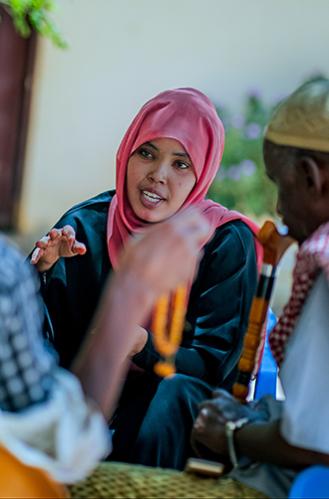
68.5
млн.
2017-жылдын аягында куугунтук, кагылышуу, зордук-зомбулук же адам укуктарынын бузулушунан улам 68,5 миллион адам аргасыз жер которгон.
10
млн.
Кеминде 10 миллион адамдын жарандыгы жок жана ошол себептен негизги укуктардан ажыратылган.
1.26
триллион АКШ доллары
Коррупция, паракорлук, уурулук жана салык төлөөдөн качуу өнүгүп келе жаткан өлкөлөргө жылына 1,26 триллион доллар чыгым алып келет.
49
өлкөдө
49 өлкөдө аялдарды үй-бүлөлүк зомбулуктан коргогон мыйзамдар жок
46
өлкөдө
46 өлкөдө аялдар азыр улуттук парламенттин жок дегенде бир палатасындагы орундардын 30 пайыздан ашыгын ээлеп турушат.
1
млрд.
1 миллиард адам мыйзамдуу түрдө ким экенин далилдей албагандыктан, юридикалык жактан “көрүнбөгөн адамдардын” катарында. Анын ичинде туулгандан бери эч качан катталбаган 14 жашка чейинки болжол менен 625 миллион бала.
Максаттар
- Дүйнөнүн бардык жеринде зордук-зомбулуктун бардык түрлөрүн жана ага байланыштуу өлүмдөрдүн көрсөткүчтөрүн олуттуу кыскартуу;
- Балдарга карата мазактоону, эксплуатацияны, сатууну жана зомбулуктун, кыйноонун бардык түрлөрүн жоюу;
- Улуттук жана эл аралык деңгээлде укуктун үстөмдүгүнө көмөк көрсөтүү жана баарына бирдей адилеттүүлүктү камсыз кылуу;
- 030-жылга чейин мыйзамсыз каражаттардын жана курал-жарактын агымын олуттуу төмөндөтүү, уурдалган активдерди табуу жана кайтаруу боюнча ишмердикти активдештирүү жана уюшкан кылмыштуулуктун бардык түрүнө каршы күрөш жүргүзүү;
- Коррупциянын жана паракорчулуктун бардык түрүнүн көлөмүн олуттуу азайтуу;
- Бардык деңгээлдеги натыйжалуу, эсеп берүүчү жана ачык-айкын ишканаларды түзүү;
- Коомчулуктун бардык катмарларынын катышуусу менен бардык деңгээлде репрезентативдик органдардын жоопкерчиликтүү чечим кабыл алуусун камсыз кылуу;
- Өнүгүп келе жаткан өлкөлөрдүн жалпы жөнгө салуу органдарынын ишмердигине катышуусун арттыруу жана активдештирүү;
- 2030-жылга чейин бардык адамдарда мыйзамдуу өздүгүн тактаган күбөлүктөрдүн, анын ичинде туулгандыгы тууралуу күбөлүктүн болуусун камсыз кылуу;
- Улуттук мыйзамдарга жана эл аралык келишимдерге ылайык, коомчулуктун маалыматтарга ээ болуусун камсыз кылуу жана негизги эркиндиктерин коргоо;
- Зомбулуктун алдын алууда, терроризм жана кылмыштуулукка каршы күрөшүүдө бардык деңгээлдердин, көбүнчө өнүгүп жаткан өлкөлөрдүн потенциалын өстүрүү максатында тийиштүү улуттук мекемелерди чыңдоо, анын ичинде эл аралык кызматташтыктын натыйжасында чыңдоо;
Туруктуу өнүктүрүүнүн кызыкчылыгы үчун дискриминациялык эмес мыйзамдарды жана саясатты демилгелөө жана кабыл алдыруу.
ТӨМ ИШ ЖҮЗҮНДӨ
Максат 17
ТӨМ максаттары үчүн өнөктөштүктөр
Туруктуу өнүгүү максаттары күчтүү глобалдык өнөктөштүк жана кызматташтык менен гана ишке ашат. “Өнүктүрүүгө багытталган расмий жардам” 2017-жылы 147 миллиард АКШ доллар максатталгандан аз болгонуна карабай, туруктуу бойдон калды. Чыр-чатактар же табигый кырсыктар менен коштолгон гуманитардык кризистер дагы деле көбүрөөк каржы булактарын жана жардамдарды талап кылууда. Ошондой эле көптөгөн өлкөлөр өнүгүү жана сооданы стимулдаштыруу үчүн“Расмий Өнүктүрүү Жардамына” муктаж.
Дүйнө мурда болуп көрбөгөндөй тыгыз байланышта. Техннологияга жана билимге жетүү мүмкунчүлүгүн жакшыртуу, пикирлерди бөлүшүү жана инновацияларды өнүктүрүүнүн маанилүү жолу болуп эсептелет. Өнүгүп келе жаткан өлкөлөргө карыздарын башкарууга жардам берүү үчүн координациялоо саясаттары, ошондой эле аз өнүккөн өлкөлөр үчүн инвестиция тартуу туруктуу өсүү жана өнүгүү үчүн абдан маанилүү болуп эсептелет.
Максаттар, мерчемделген пландарга жетүү үчүн улуттук пландарды колдоо аркылуу Түндүк-Түштүк жана Түштүк-Түштүк кызматташтыгын арттырууга багытталган. Эл аралык сооданы илгерилетүү жана өнүгүп келе жаткан өлкөлөргө экспортту көбөйтүүгө жардам берүү – бул негизги универсалдуу эрежелерге жана калыс, ачык жана бардыгынын пайдасына болгон адилеттүү соода системасына жетишүүнүн бир бөлүгү.
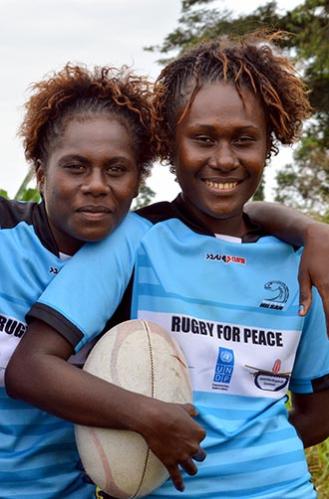
$5
триллион
Бириккен Улуттар Уюмунун соода жана өнүктүрүү боюнча конференциясы ТӨМгө жетишүү үчүн жылына 5 триллиондон 7 триллион АКШ долларына чейин инвестиция талап кылынат деп билдирди.
$147.2
млрд.
2017-жылы өнүгүүгө жумшалган жалпы расмий жардамдын саны 147,2 миллиард АКШ долларына жеткен.
$613
млрд.
2017-жылы эл аралык акча которуулар 613 миллиард АКШ долларын түздү; Мунун 76 пайызы өнүгүп келе жаткан өлкөлөргө туура келген
6
өлкө
2016-жылы 6 өлкө өздөрүн өнүктүрүү боюнча расмий жардамды улуттук дүң кирешенин 0,7 пайызынан жогору кармап туруу боюнча эл аралык максатты аткарды.
$18.2
триллион
Туруктуу жана жоопкерчиликтүү инвестициялар ТӨМ үчүн капиталдын потенциалдуу булагы болуп саналат. 2016-жылга карата бул активдер классына 18,2 триллион доллар инвестицияланган.
$155.5
млрд.
Туруктуу бизнес үчүн облигациялар рыногу өсүп жатат. 2018-жылы глобалдык жашыл облигациялар 155,5 миллиард долларга жетип, мурунку жылга салыштырмалуу 78% га өстү.
Максаттар
Финансы
- Салык жыйноо жана башка кирешелер боюнча ички потенциалды жакшыртуу үчүн, ички ресурстарды, анын ичинлде өнүгүп келе жаткан өлкөлөргө эл аралык колдоо аркылуу мобилизациялоону күчөтүү;
- Өнүккөн өлкөлөр “Өнүктүрүүгө багытталган расмий жардам” (ӨРЖ) боюнча өзүнүн милдеттерин толук аткаруусун камсыз кылуу, анын ичинде көптөгөн өлкөлөр өзүнүн улуттук дүң кирешесинин (УДК) 0,7 пайыз деңгээлинде өнүгүп жаткан өлкөлөргө ӨРЖ тилкеси боюнча каражаттарды бөлүүнүн максаттык көрсөткүчтөрүнө жетүү милдеттерин аткаруусу жана азыраак өнүккөн өлкөлөргө өзүнүн УДКдан 0,15-0,20 пайыз деңгээлинде ӨРЖ бөлүүсү; ӨРЖ берген мамлекеттерге өзүнүн УДКнын 0,20 пайыздан аз эмес көлөмүн ӨРЖ тилкеси боюнча азыраак өнүккөн өлкөлөргө бөлүү максатын коюу жөнүндө маселени кароо сунушталат;
- Ар кандай булактардан өнүгүп келе жаткан өлкөлөр үчүн кошумча каражаттарды мобилизациялоо;
- Өнүгүп келе жаткан өлкөлөргө карызды каржылоого, карызды жеңилдетүүгө жана зарыл болгон учурда карызды реструктуризациялоого багытталган координацияланган саясат аркылуу узак мөөнөттүү карыздын туруктуулугуна жетишүүгө жардам берүү жана карыз кыйынчылыгын азайтуу үчүн өтө карызы бар жакыр өлкөлөрдүн тышкы карыз маселесин чечүү;
- Эң аз өнүккөн өлкөлөр үчүн инвестицияларды тартуу режимдерин кабыл алуу жана ишке ашыруу.
Технология
- Түндүк-Түштүк, Түштүк-Түштүк жана үч тараптуу региондук жана эл аралык кызматташтыкты өркүндөтүү, илимге, технологияга жана инновацияларга жетүү мүмкүнчүлүгүн түзүү жана өз ара макулдашылган шарттарда, анын ичинде өзгөчө Бириккен Улуттар Уюмунун деңгээлиндеги механизмдер арасында координацияны жакшыртуу жана глобалдык технологияны жеңилдетүү механизми аркылуу маалымат алмашууну активдештирүү;
- Өз ара макулдашуунун негизинде өнүгүп келе жаткан өлкөлөргө жагымдуу шарттар, анын ичинде жеңилдетилген жана преференциалдык шарттарда экологиялык жактан таза технологияларды иштеп чыгууга, берүүгө, жайылтууга жана өздөштүрүүгө көмөк көрсөтүү;
- 2017-жылга чейин эң аз өнүккөн өлкөлөр үчүн технологиялык банкты жана илимий, технологиялык жана инновациялык потенциалды жогорулатуу механизмин толук ишке киргизүү жана мүмкүнчүлүк берүүчү технологияларды, атап айтканда, маалымат жана коммуникация технологияларын колдонууну активдештирүү.
Потенциалды өстүрүү
- Туруктуу өнүгүүнүн бардык максаттарын, анын ичинде Түндүк-Түштүк, Түштүк-Түштүк жана үч тараптуу кызматташтыкты ишке ашырууга багытталган улуттук пландарды колдоо үчүн өнүгүп келе жаткан өлкөлөрдө натыйжалуу жана максаттуу потенциалды өстүрүүнү ишке ашыруу боюнча эл аралык колдоону күчөтүү.
Соода
- Бүткүл дүйнөлүк соода уюмунун алкагында, анын ичинде өнүктүрүү тармагында Доха күн тартиби боюнча сүйлөшүүлөрдүн аяктоосунун натыйжасында, универсалдуу, эрежелерге негизделген, ачык, дискриминациялык эмес жана адилеттүү көп тараптуу соода системасын демилгелөө;
- 2020-жылга чейин дүйнөлүк экспортто эң аз өнүккөн өлкөлөрдүн үлүшүн эки эсе көбөйтүү максатында өнүгүп келе жаткан өлкөлөрдүн экспортун олутту түрдө өнүктүрүү;
- Бүткүл дүйнөлүк соода уюмунун чечимдерине шайкеш келе турган негизде бардык эң аз өнүккөн өлкөлөргө узак мөөнөттүү негизде рынокко алымсыз жана квота коюлбаган кирүүгө өз учурунда ээ болуусун камсыз кылуу, анын ичинде эң аз өнүккөн өлкөлөр импорттогон товарларга карата колдонулган преференциалдык эрежелер ачык-айкын жана жөнөкөй болушун камсыз кылуу, рынокко кирүүнү жеңилдетүүгө көмөк көрсөтүү.
Систематикалык маселелер
Саясаттын ырааттуулугу жана мекемелердин ишмердиги
- Глобалдык макроэкономикалык туруктуулукту, саясатты координациялоо жана саясаттын ырааттуулугу аркылуу жогорулатуу;
- Туруктуу өнүгүү кызыкчылыгы үчүн саясаттын ырааттуулугун жогорулатуу;
- Жакырчылыкты жоюу жана туруктуу өнүгүү боюнча саясатты түзүү жана ишке ашыруу үчүн ар бир өлкөнүн саясий мейкиндигине жана жетекчилигине урмат көрсөтүү.
Көптөгөн кызыкдар жактардын катышуусу менен өнөктөштүк
- Өнүгүп келе жаткан өлкөлөр баш болуп, бардык өлкөлөрдө туруктуу өнүгүү тармагында максаттарга жетүүнү колдоо үчүн билимди, тажрыйбаны, технологияны жана финансы ресурстарын мобилизациялаган жана тараткан, көптөгөн кызыкдар жактардын катышуусунда өнөктөштүк менен толукталган туруктуу өнүгүүнүн кызыкчылыгында глобалдык өнөктөштүктү чыңдоо;
- Мамлекеттик уюмдардын ортосунда, мамлекеттик жана жеке сектордун ортосунда жана жарандык коомдун уюмдарынын ортосунда өнөктөштөрдүн ресурстарды колдонуудагы тажрыйбасына жана стратегиясына таянуу менен натыйжалуу өнөктөштүктүү өбөлгөлөө жана демилгелөө.
Маалыматтар, мониторинг жана эсеп берүү
- 2020-жылга чейин кирешесинин көлөмү, гендердик таандыгы, жашы, расасы, улуту, миграциялык статусу, майыптыгы, географиялык жайгашуусу жана башка улуттук шарттар эске алынган маанилүү мүнөздөмөлөр боюнча жогорку сапаттуу, актуалдуу жана анык маалыматтарга жетүүнү олуттуу жогорулатуу үчүн өнүгүп жаткан өлкөлөрдүн, анын ичинде азыраак өнүккөн өлкөлөрдүн жана чакан аралдардагы өнүгүп жаткан мамлекеттердин потенциалын өстүрүү максатында колдоону күчөтүү;
2030-жылга чейин азыркы демилгелерге таянуу менен, ички дүң продукттун көрсөткүчүн жана туруктуу өнүгүүнү камсыз кылуу боюнча прогрессти өлчөөнүн башка көрсөткүчтөрүнө кошумча катары статистика тармагында өнүгүп жаткан өлкөлөрдүн потенциалын өстүрүүнү иштеп чыгуу жана көмөк көрсөтүү.

 Locations
Locations